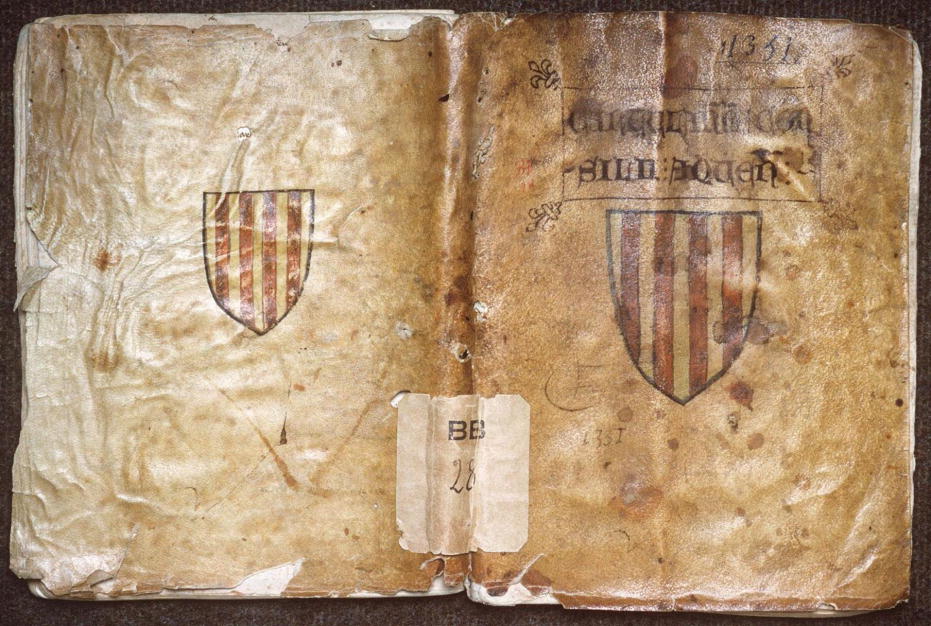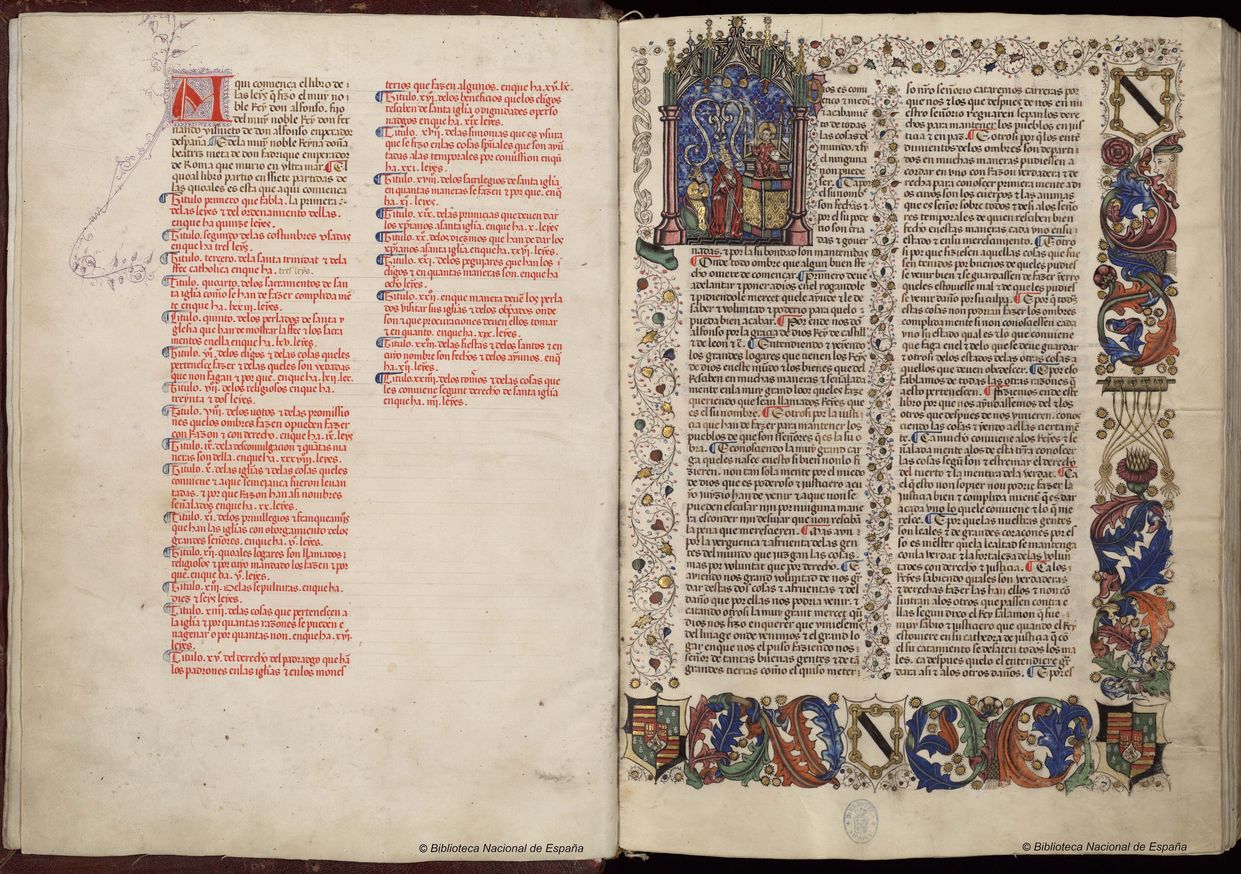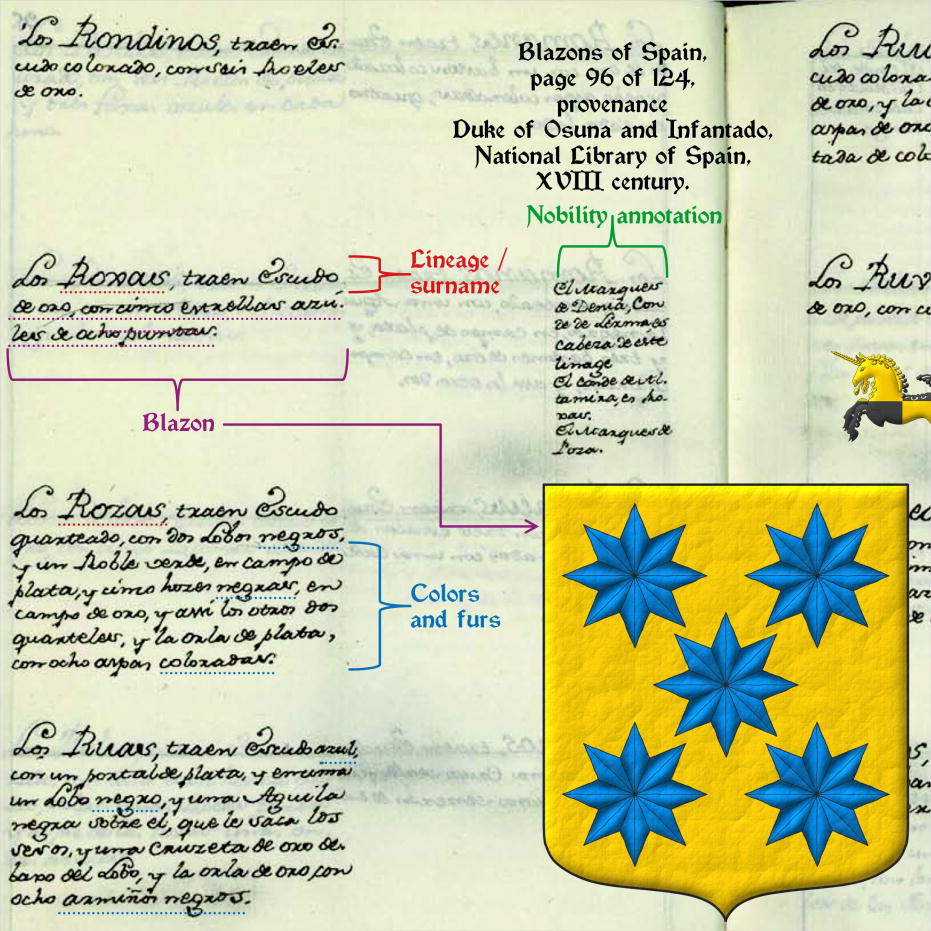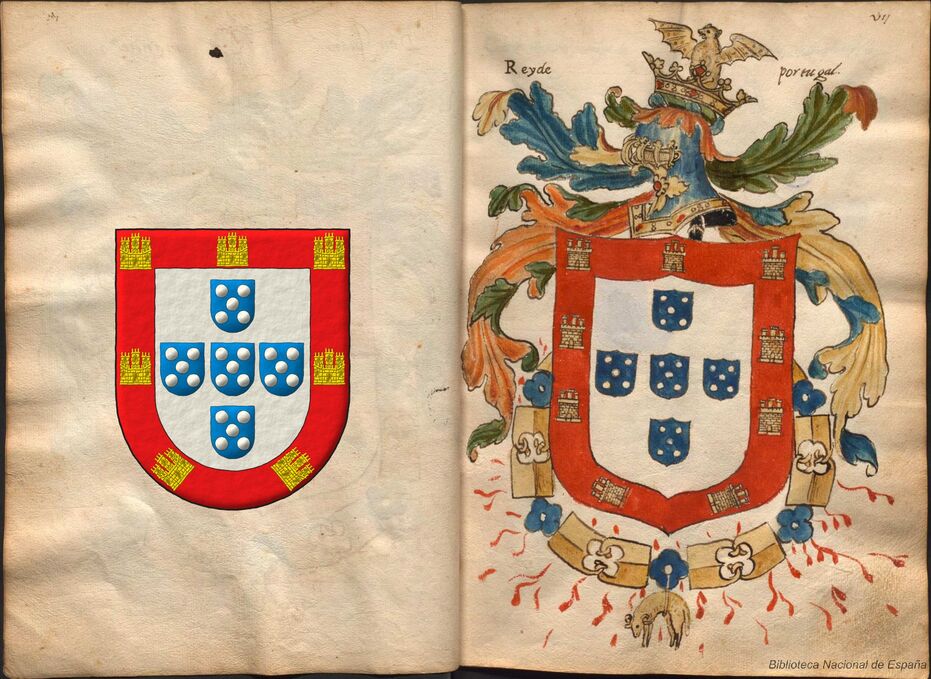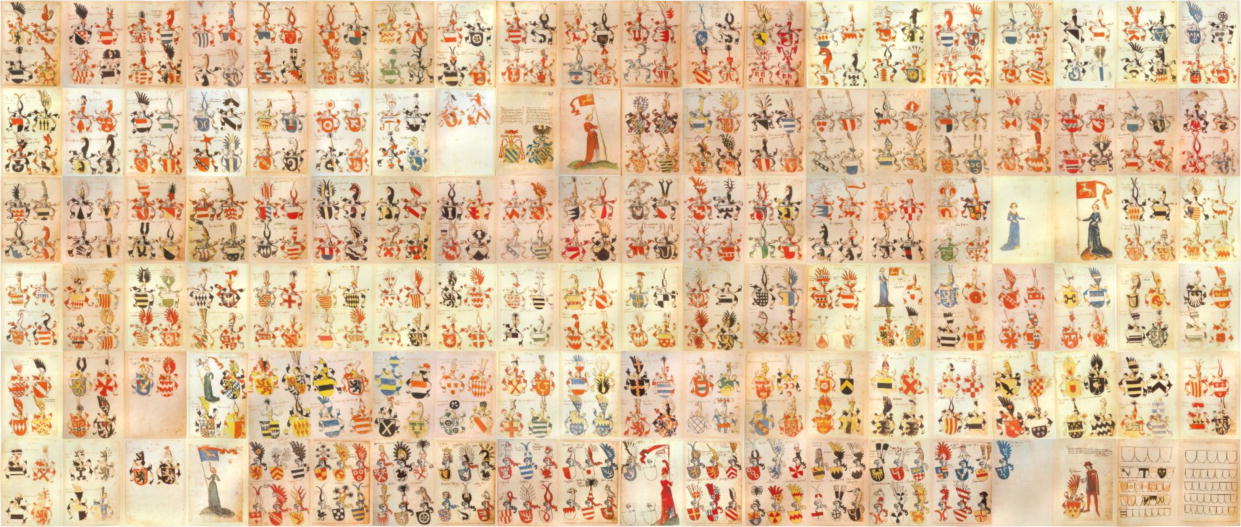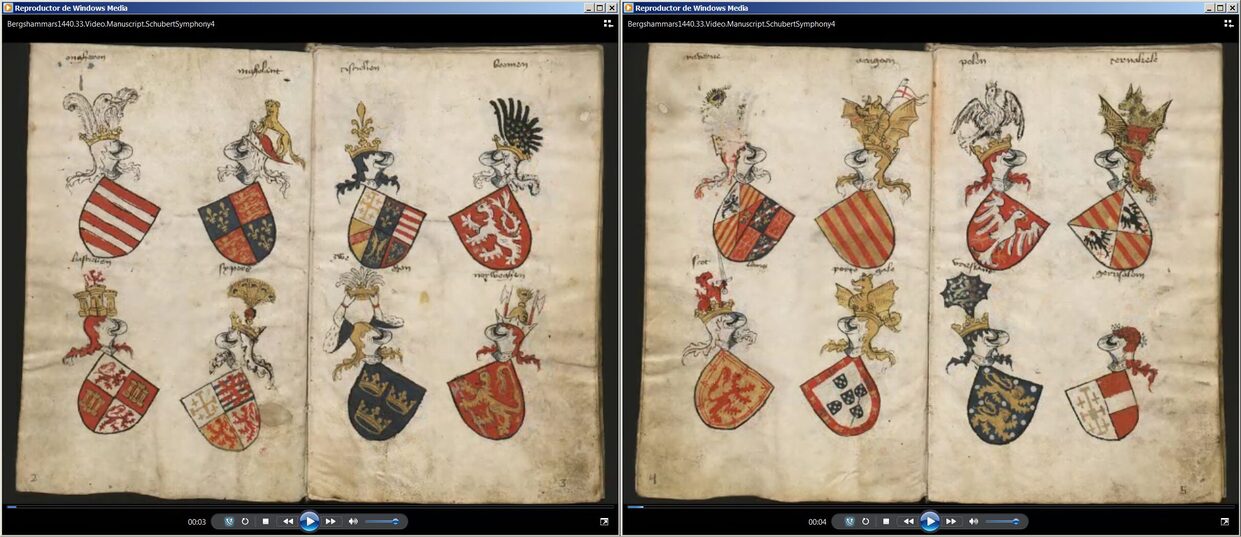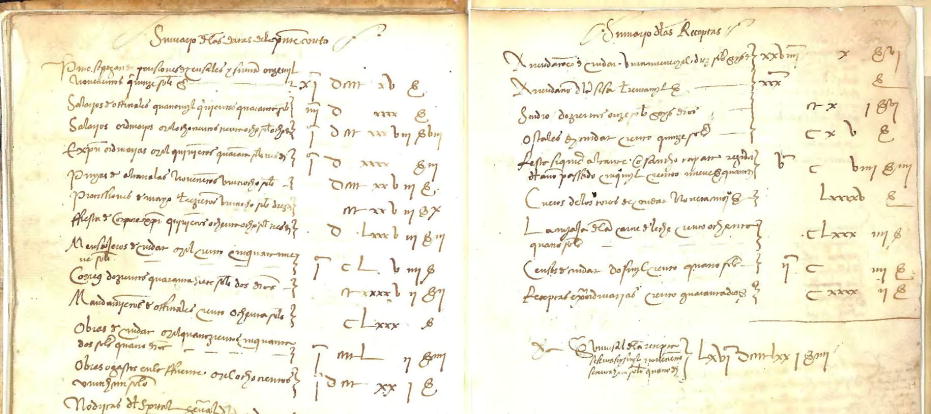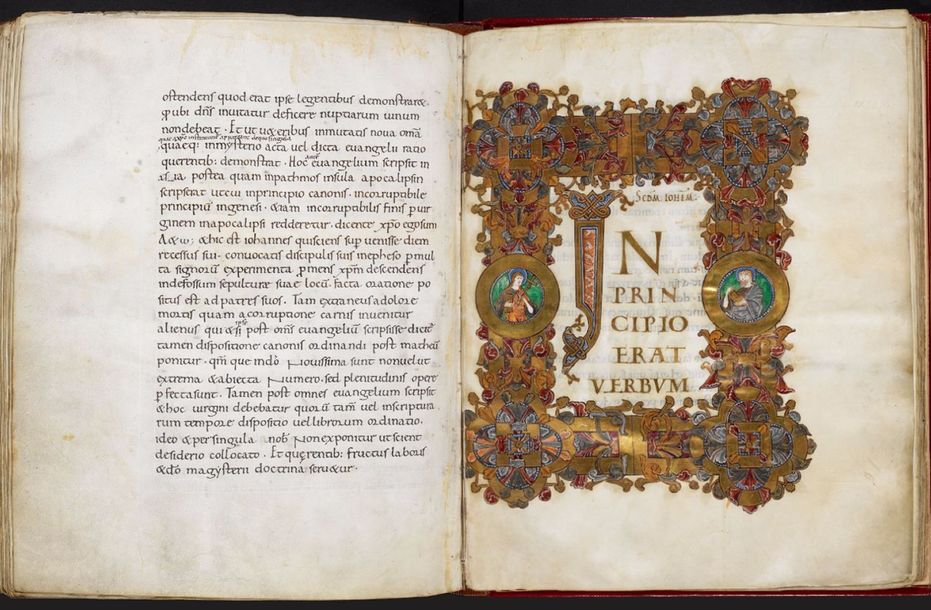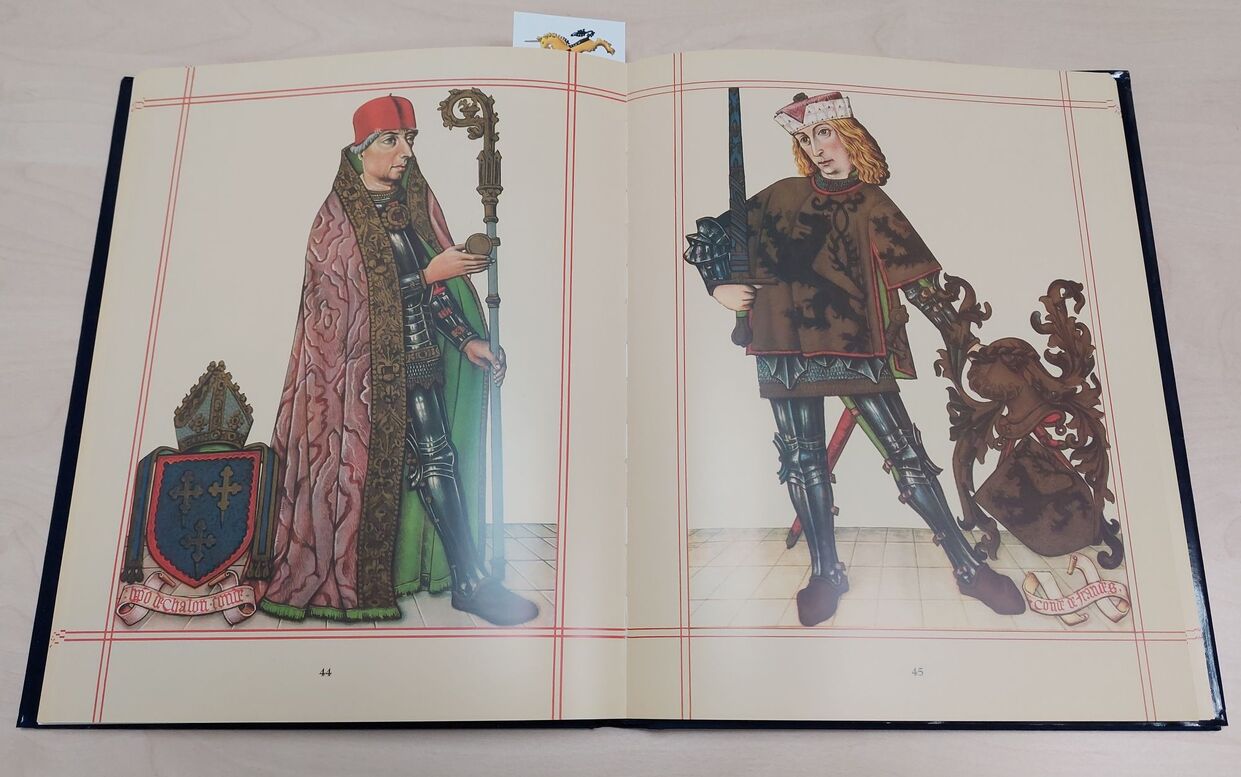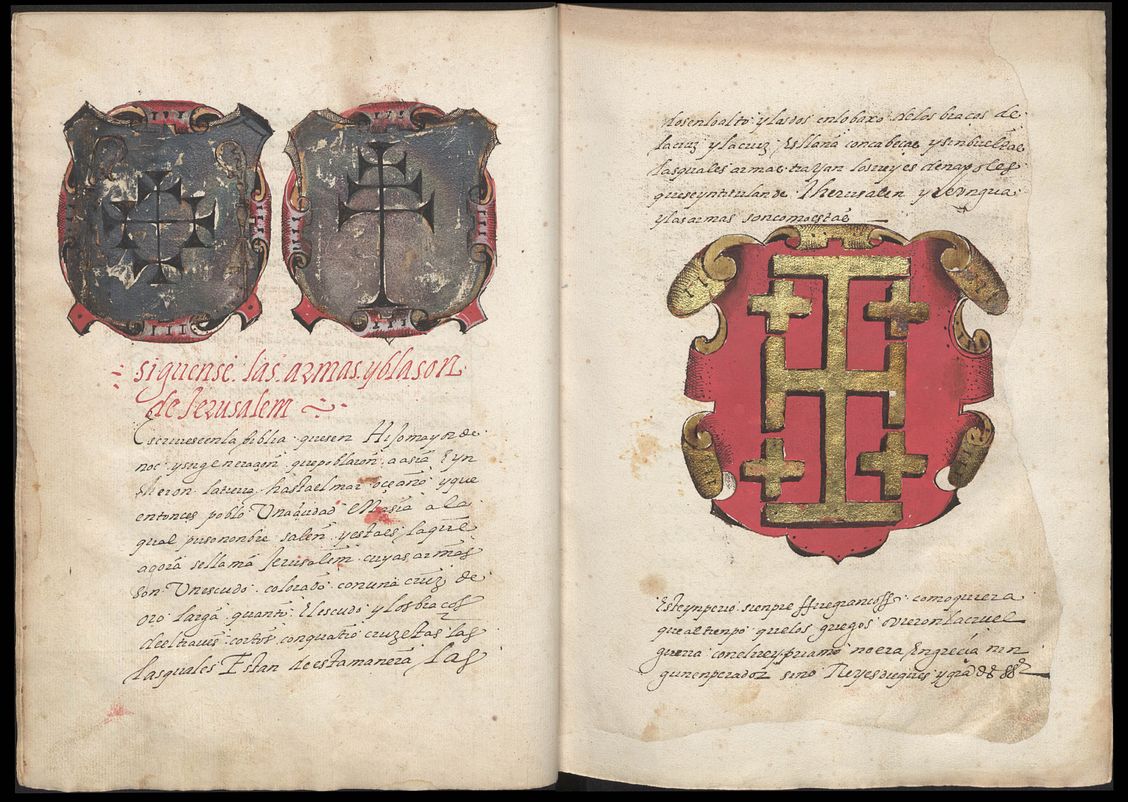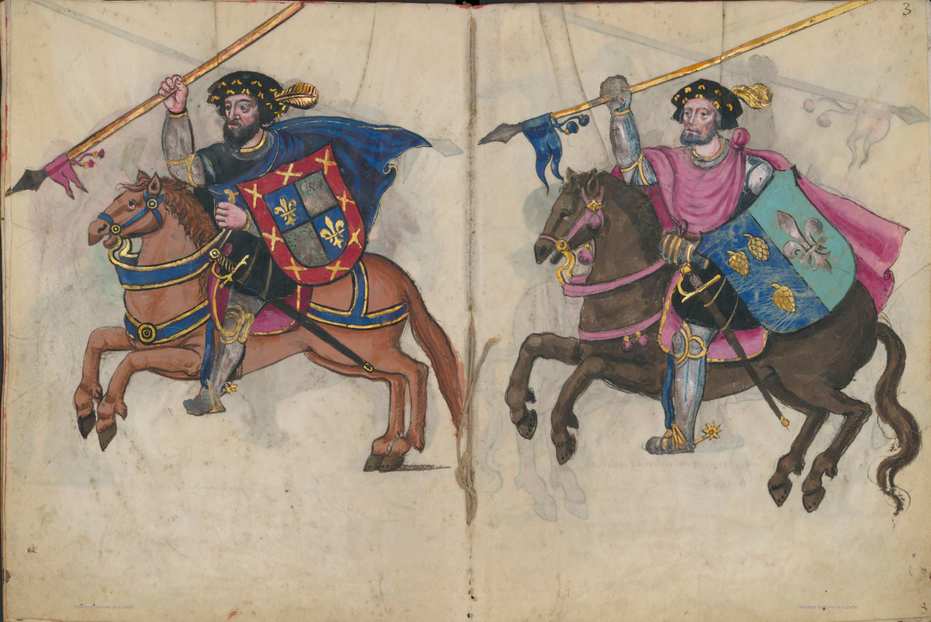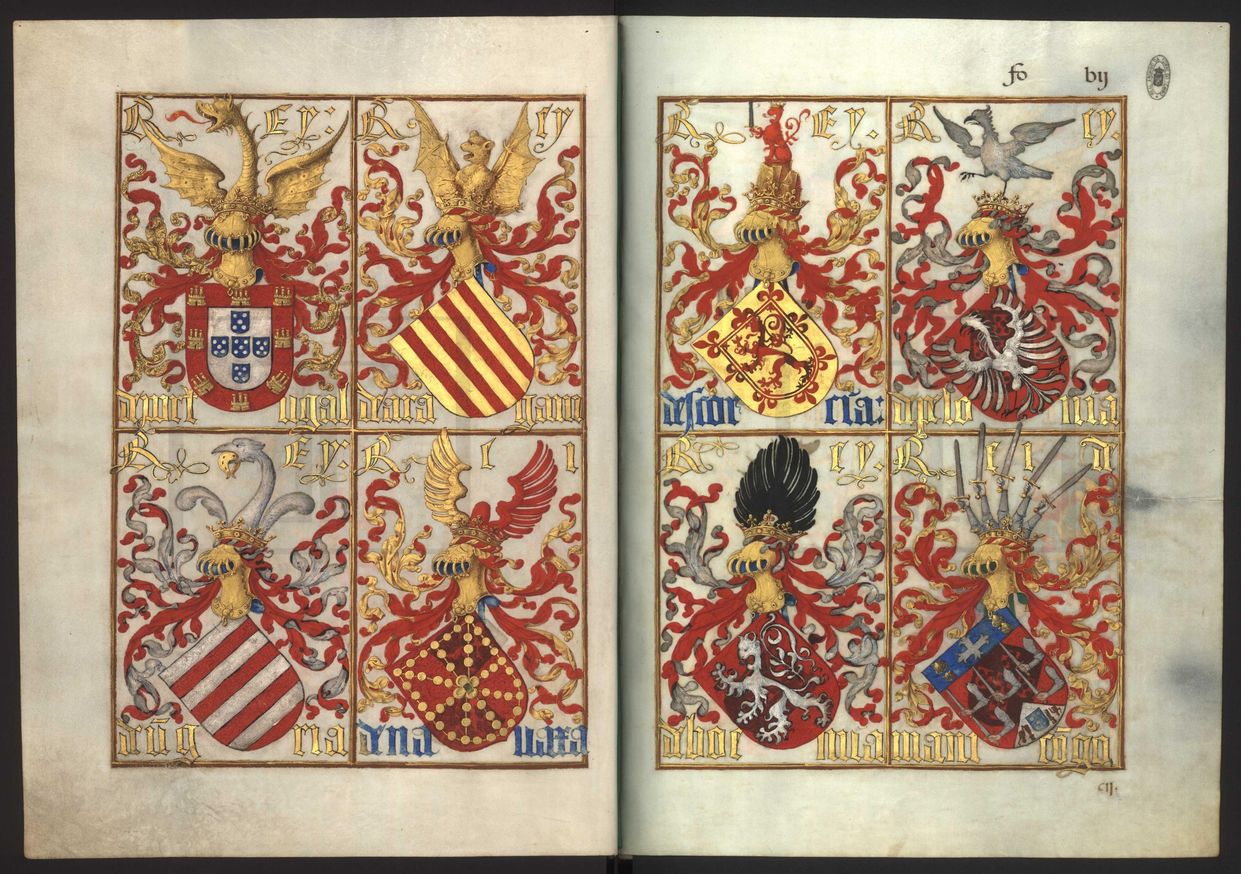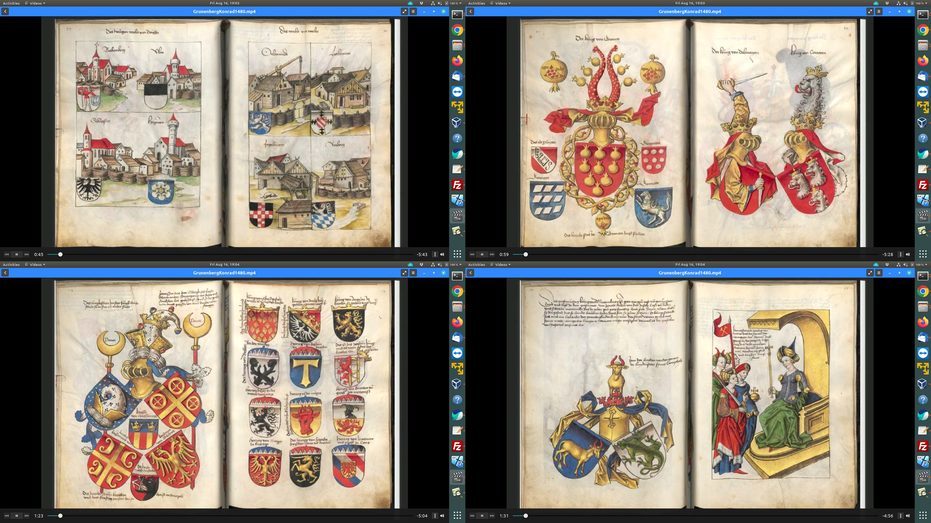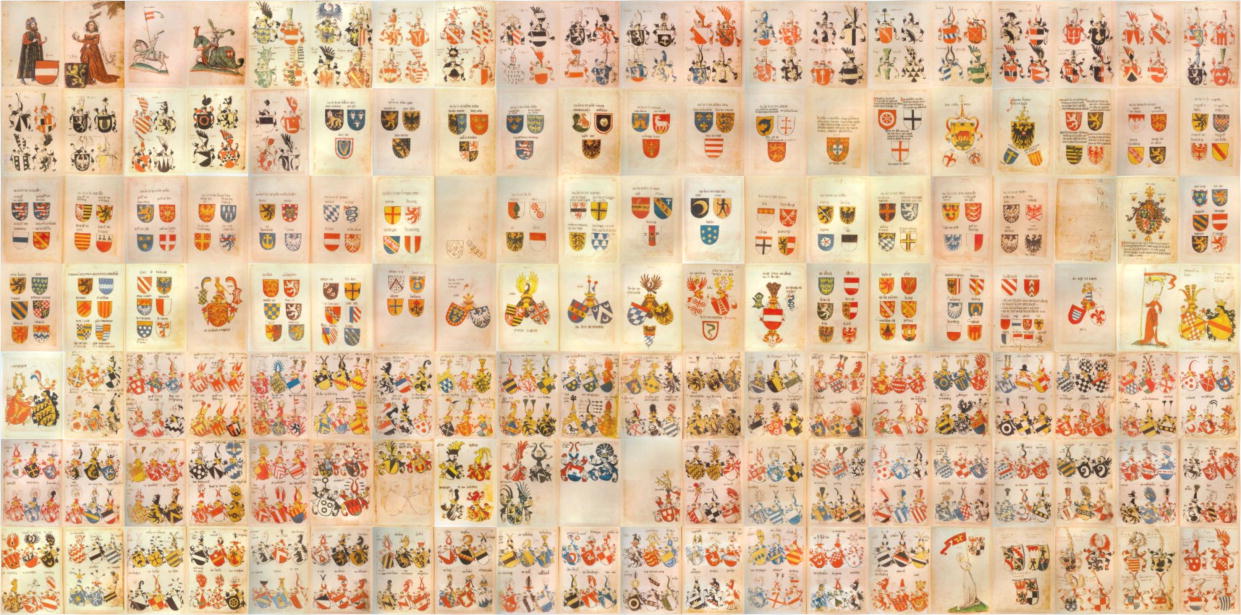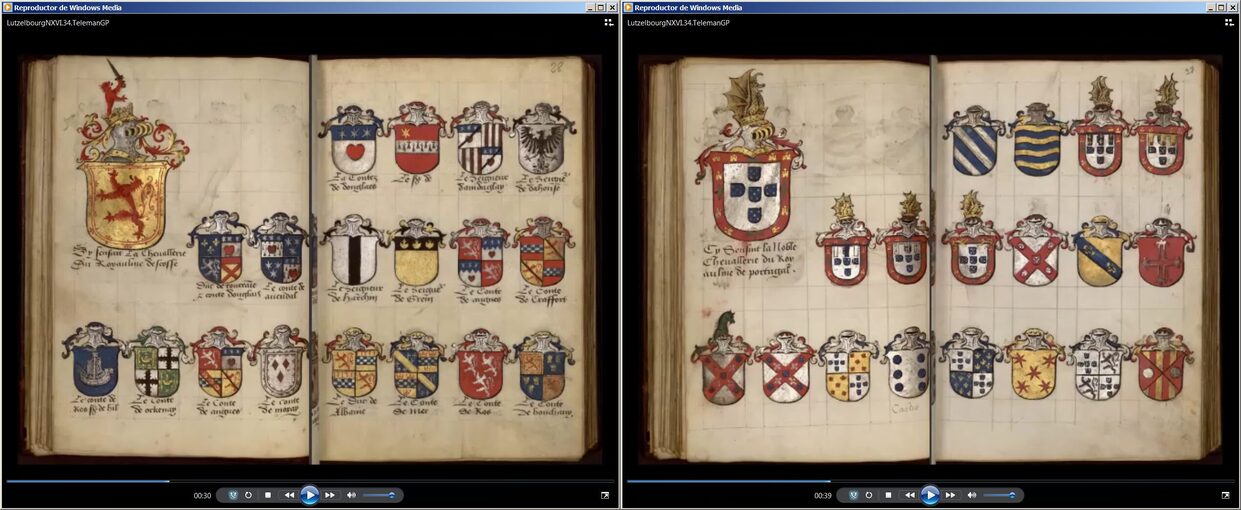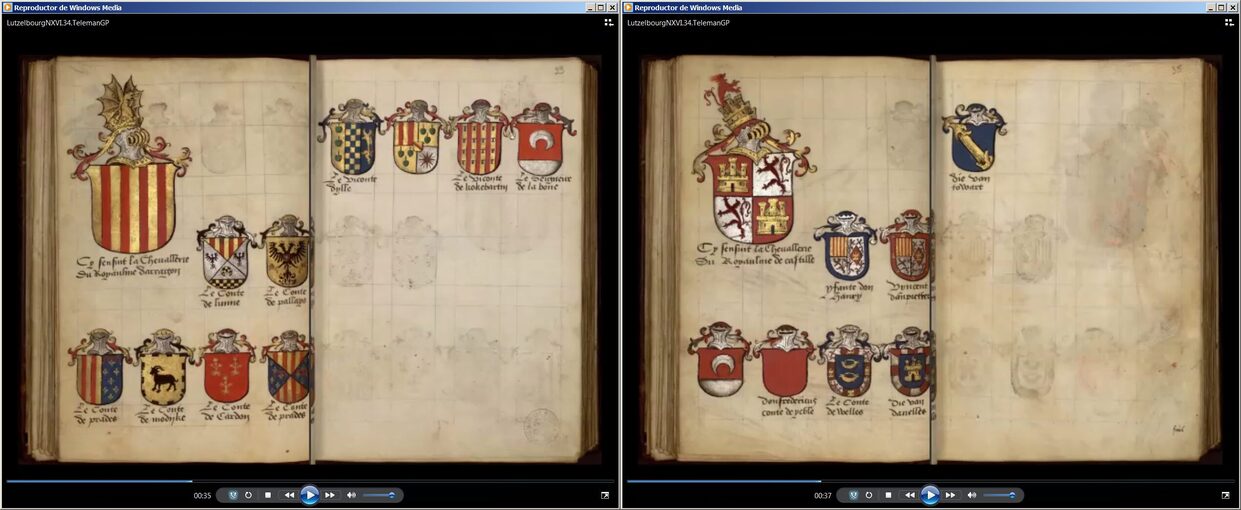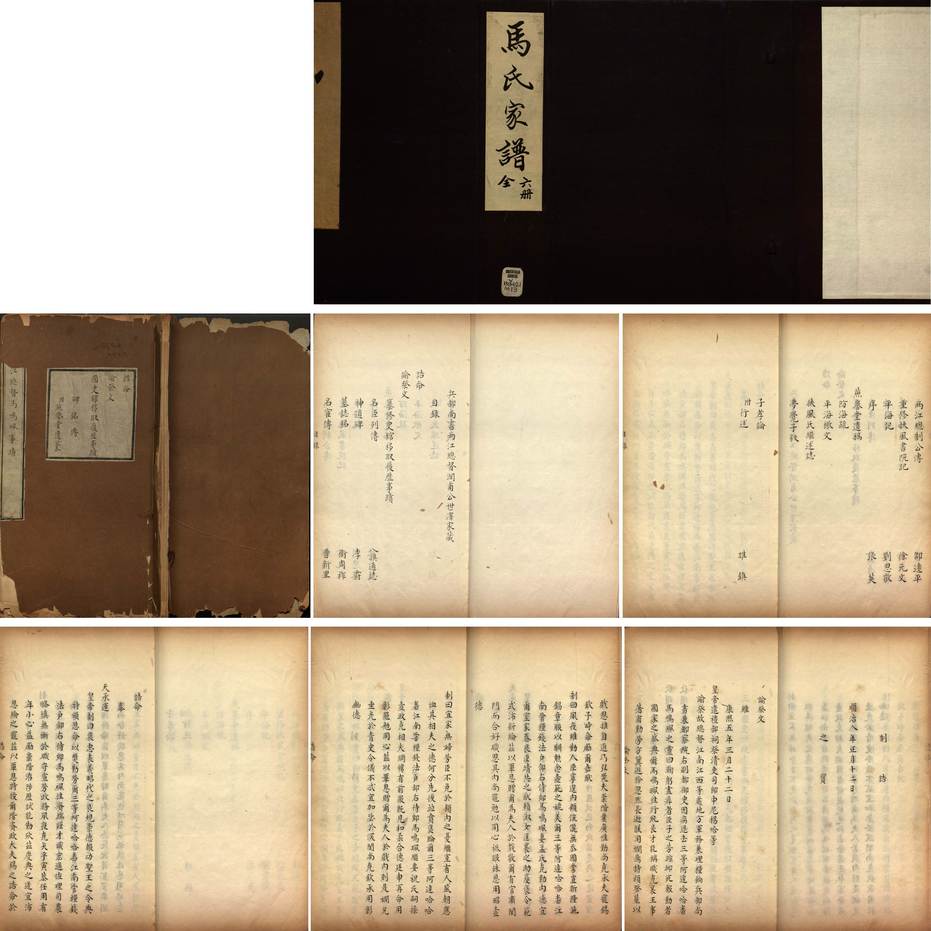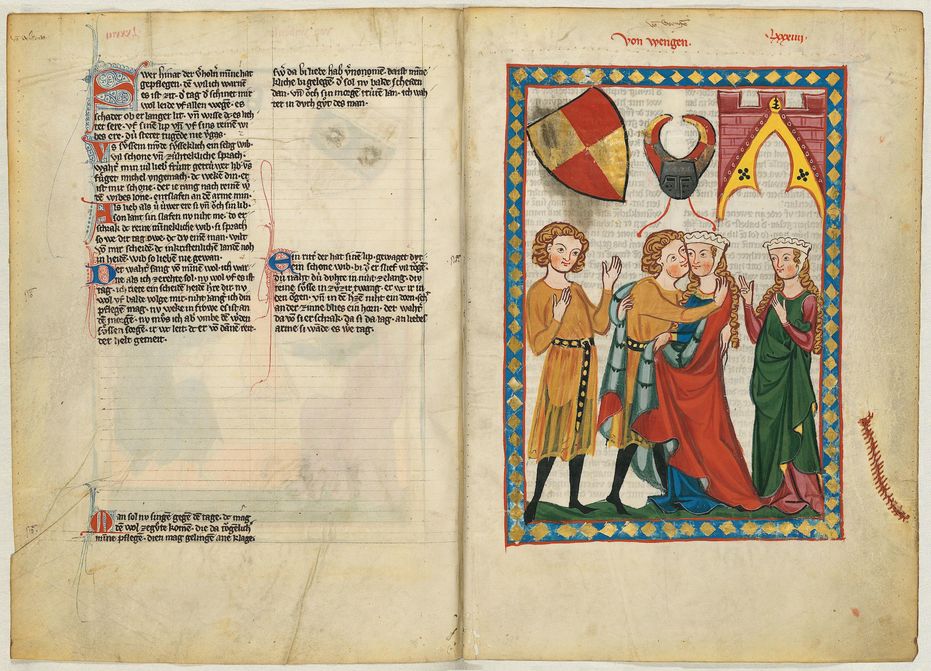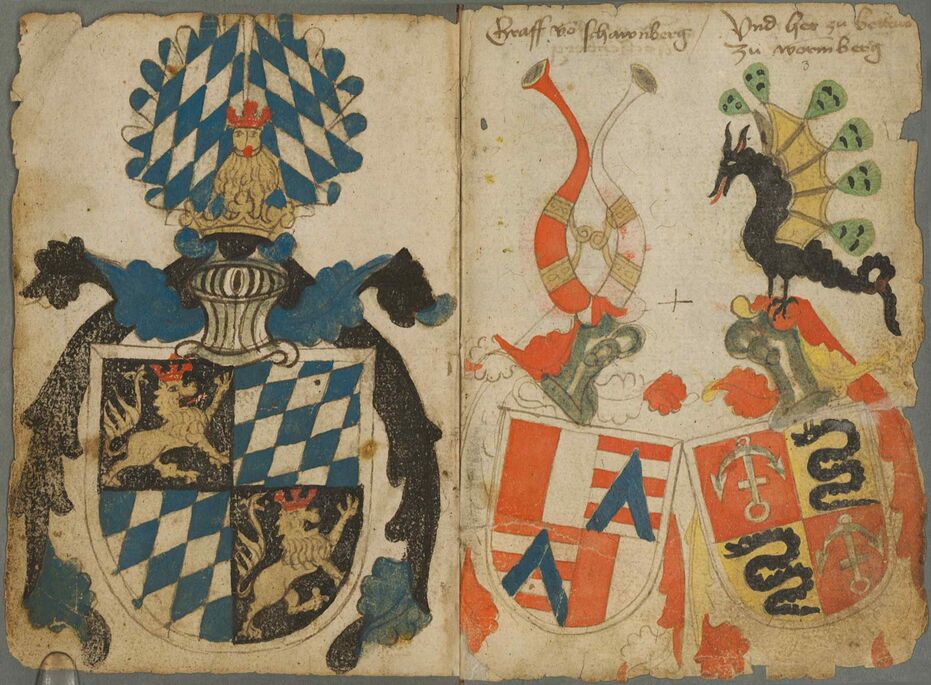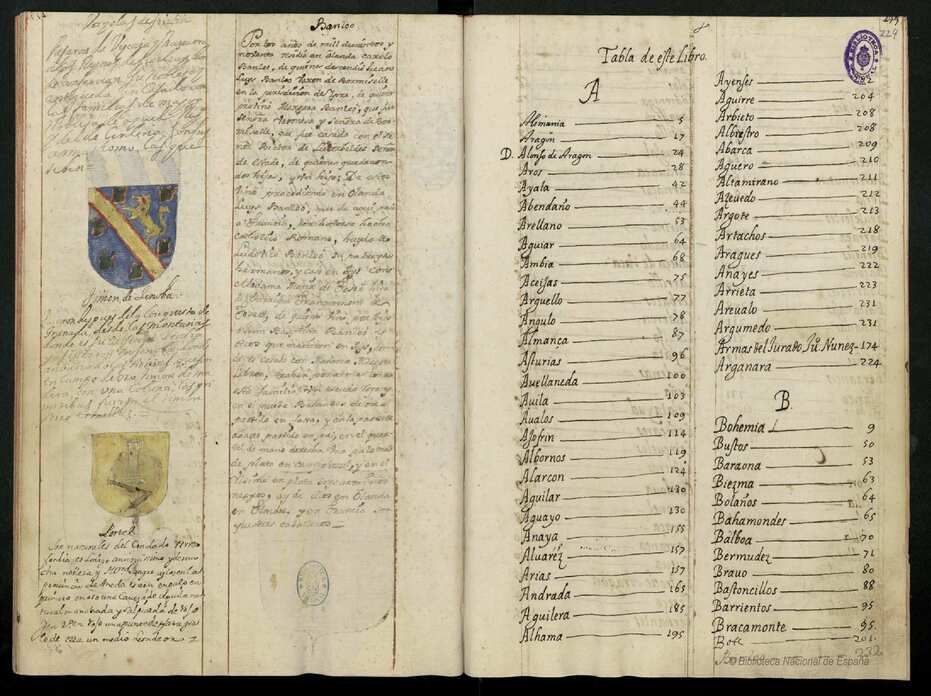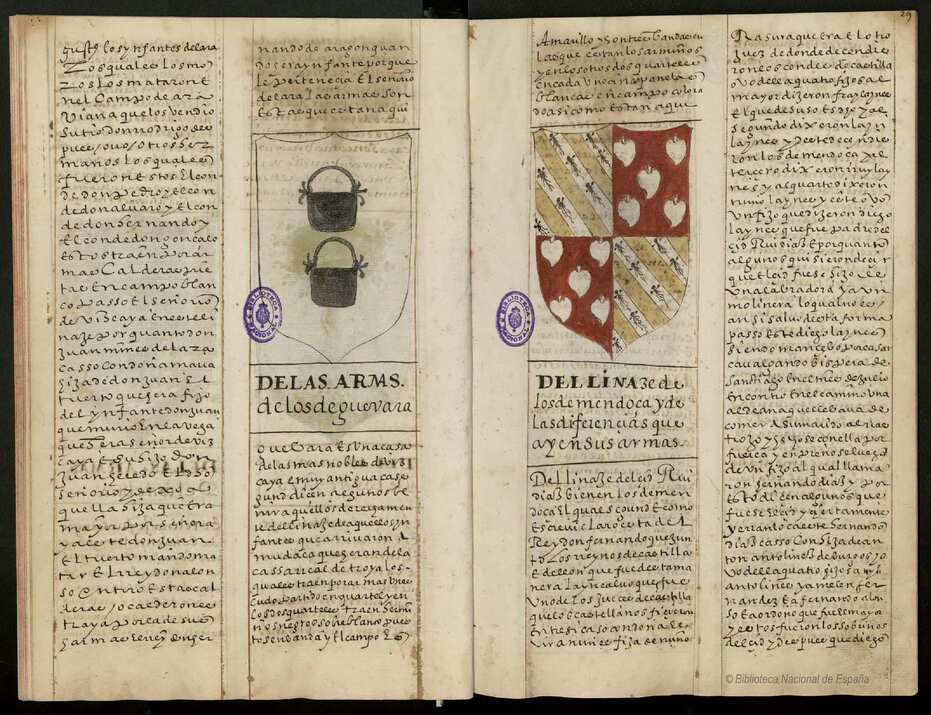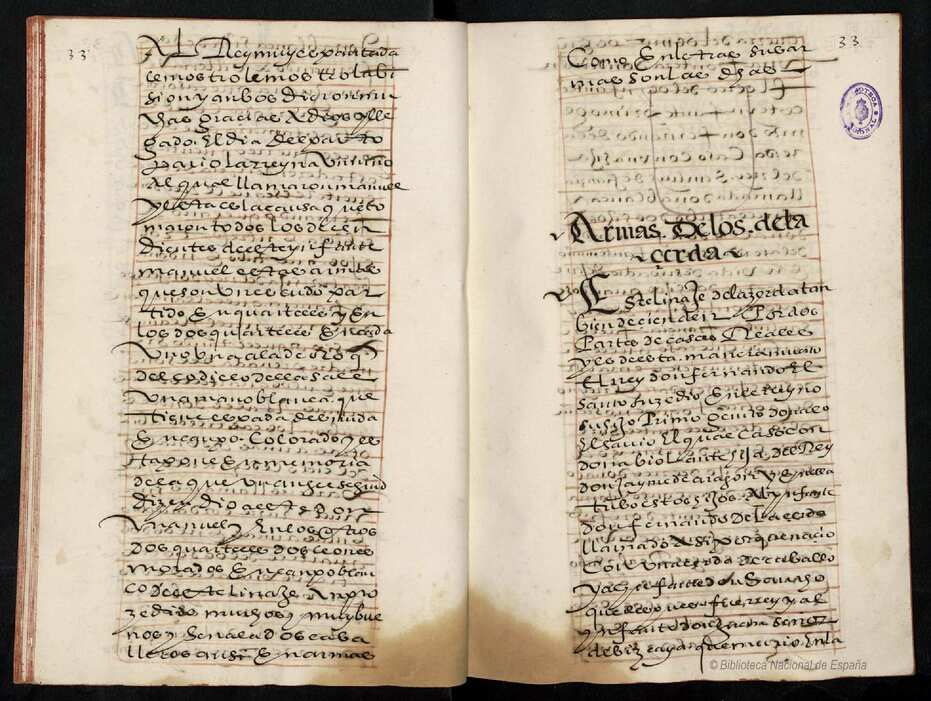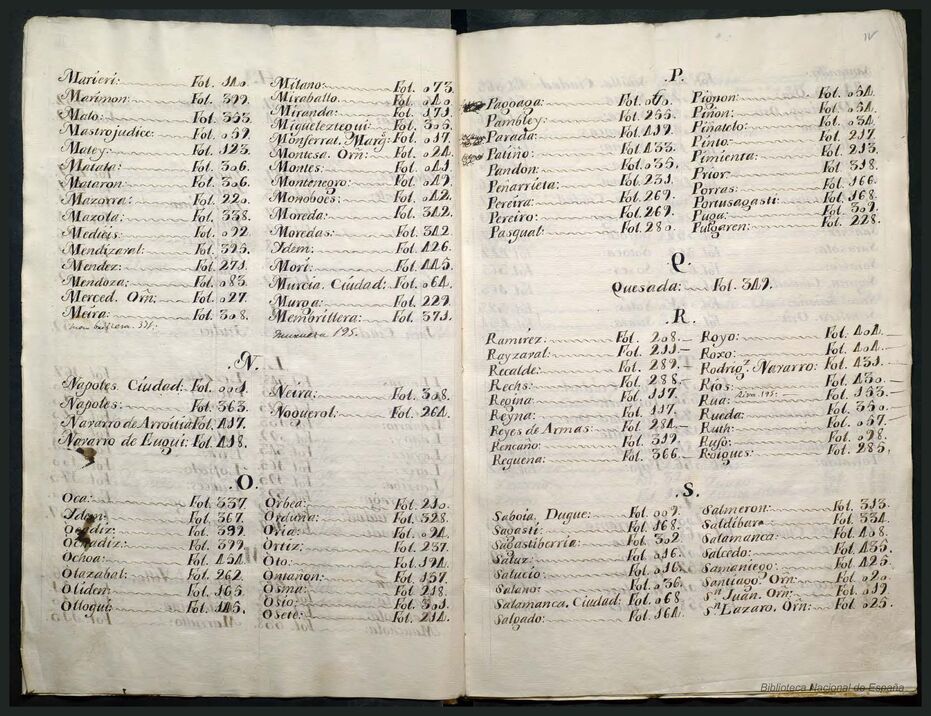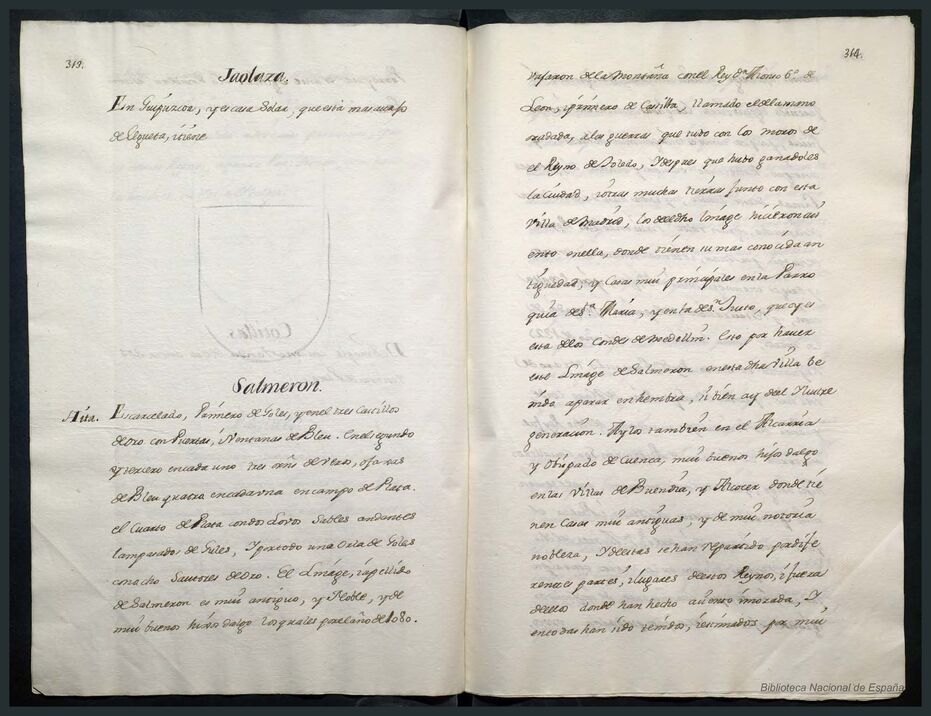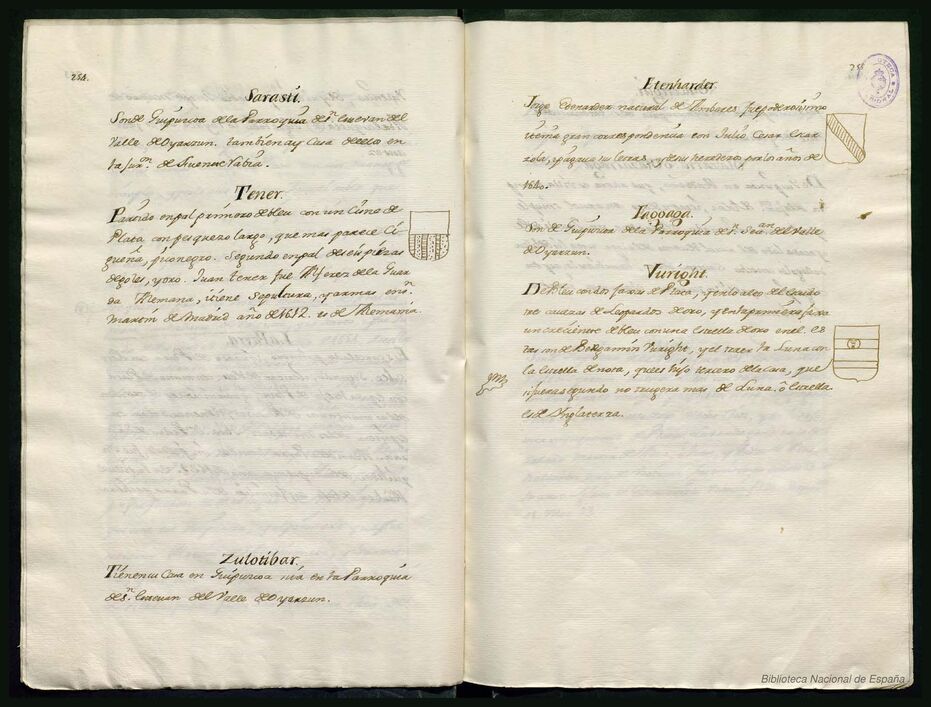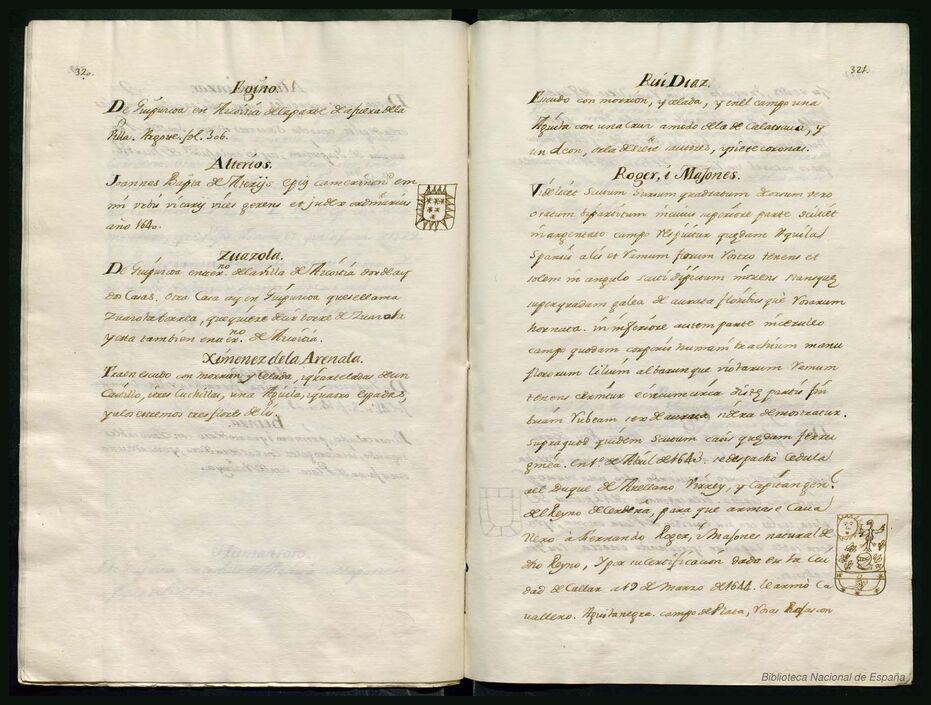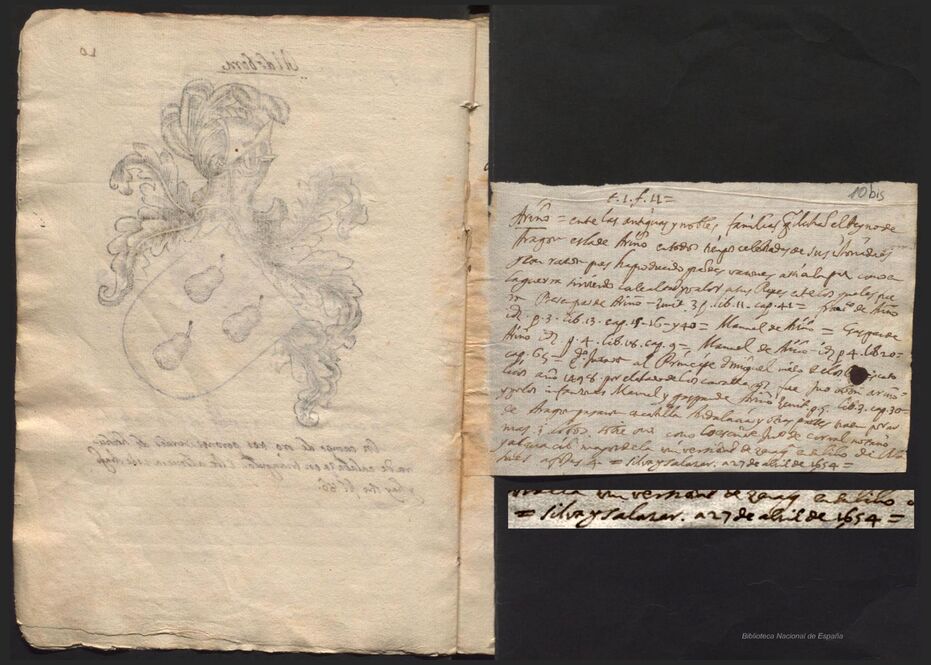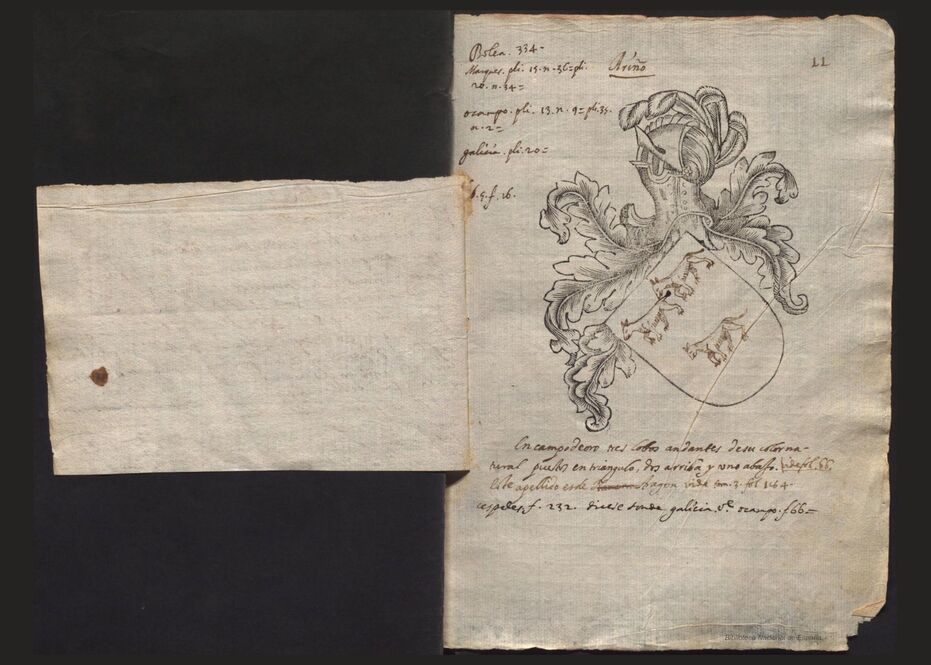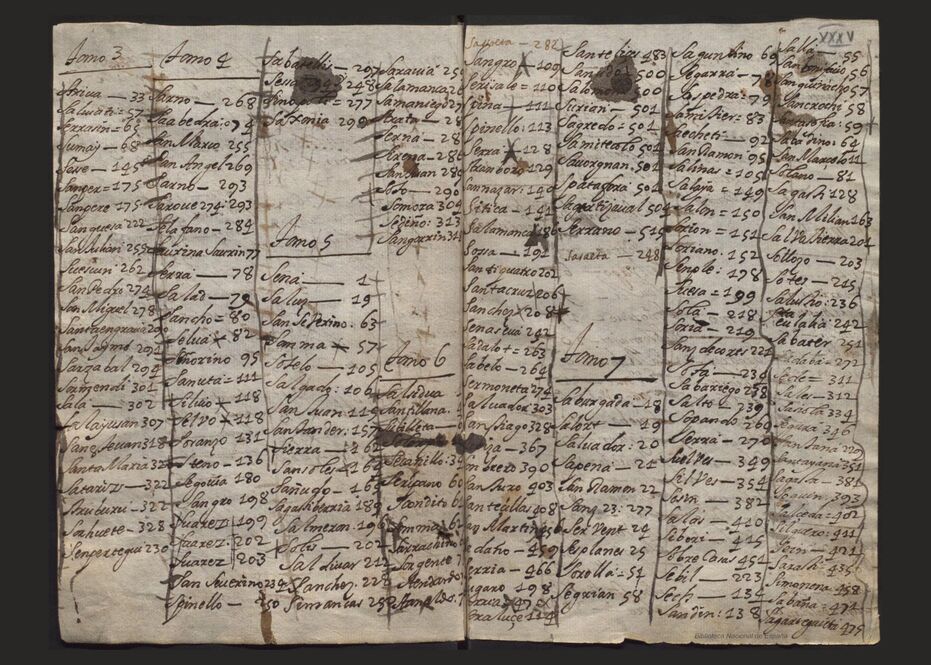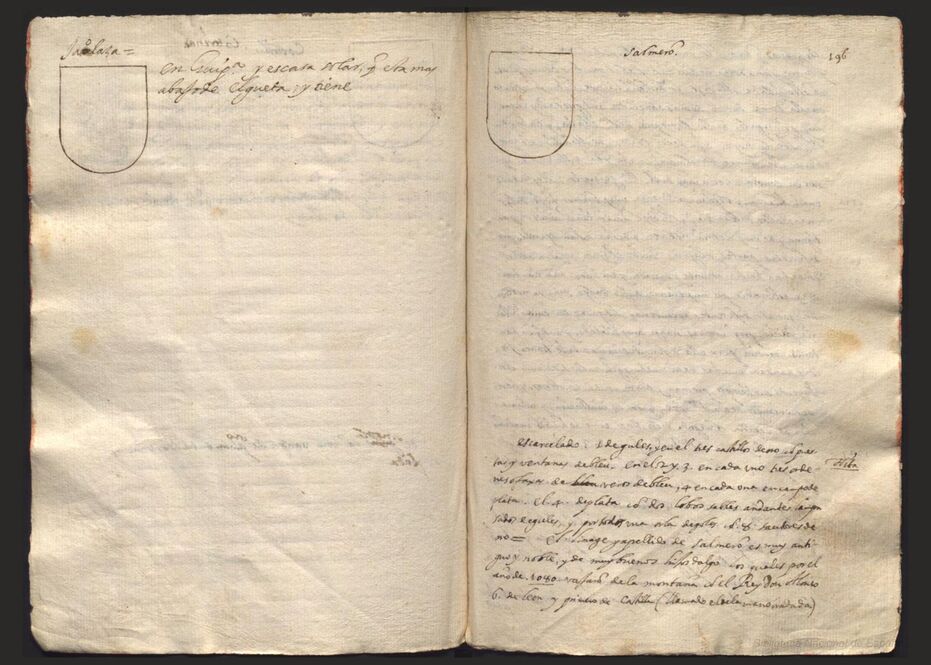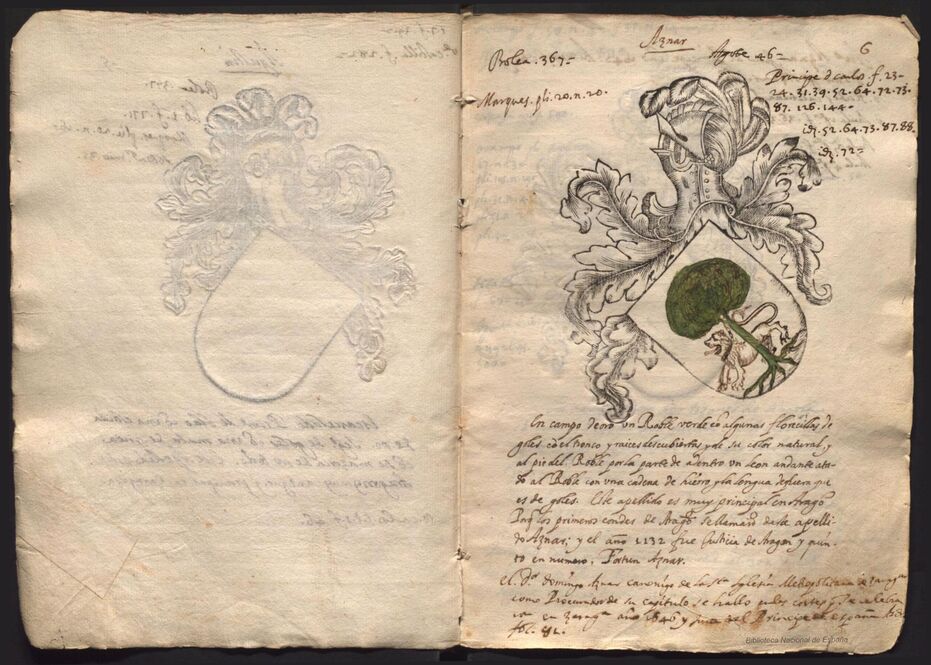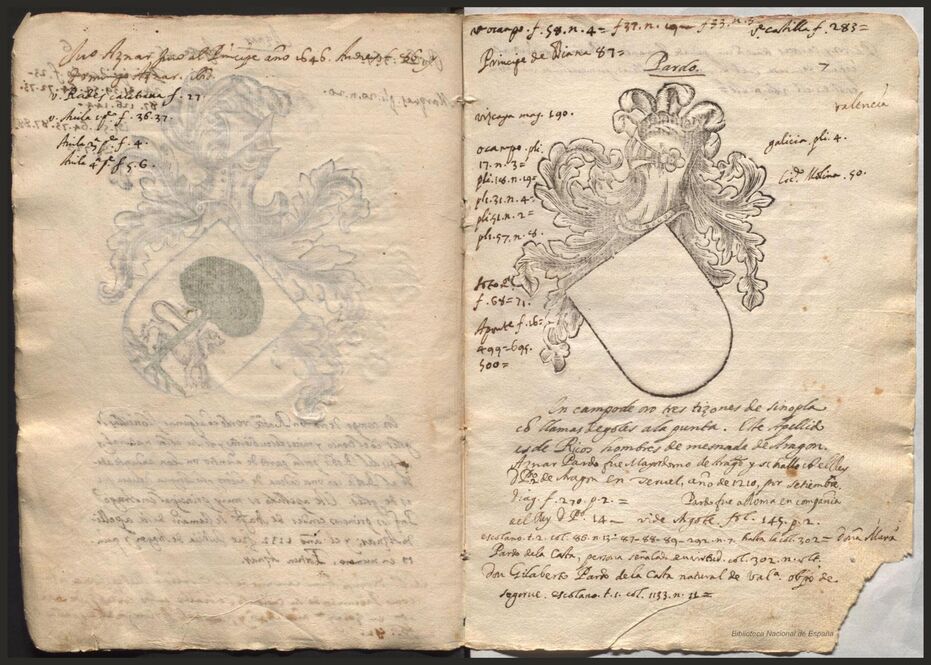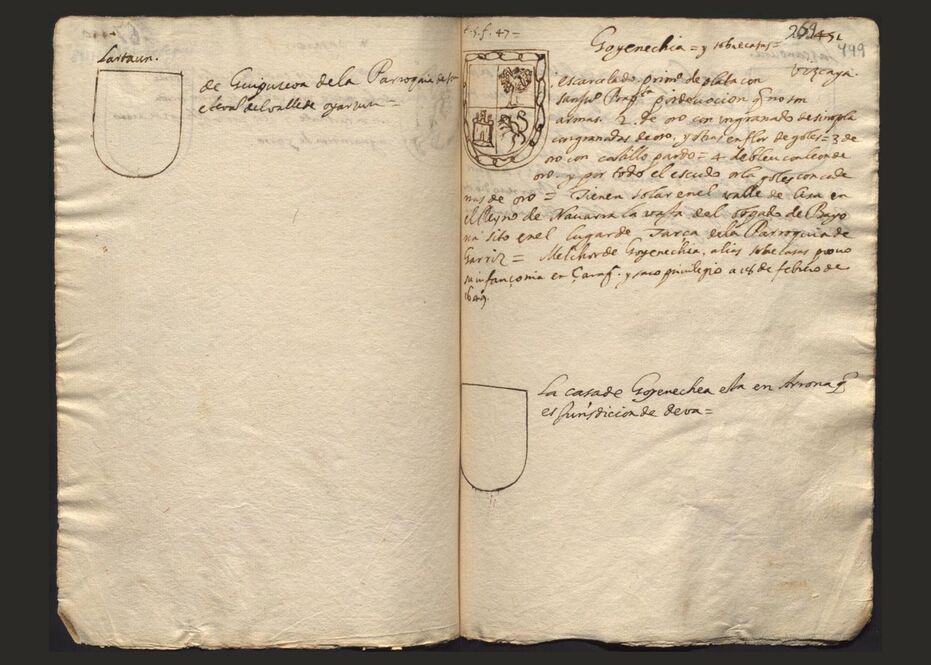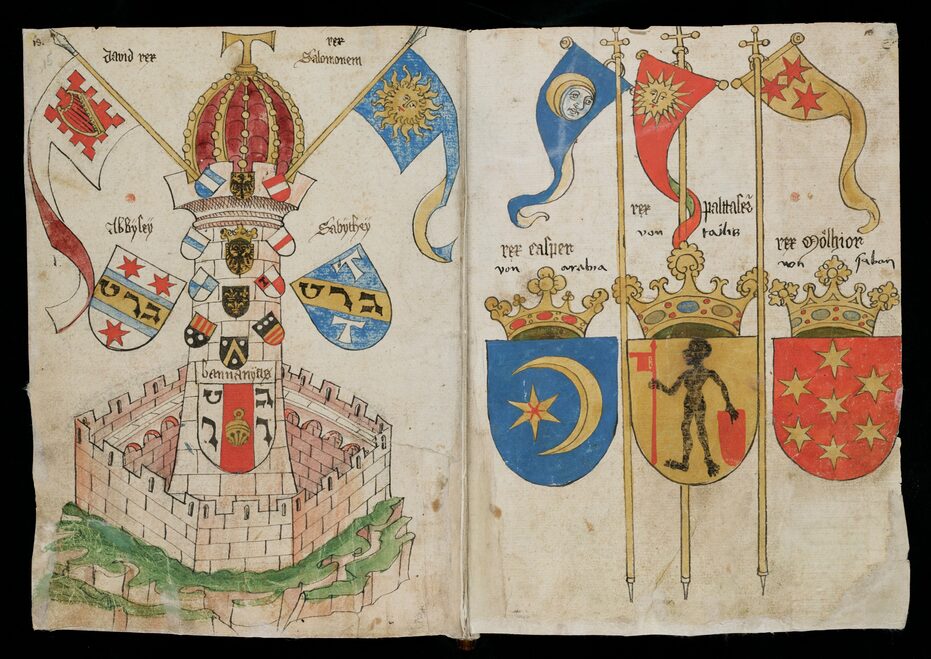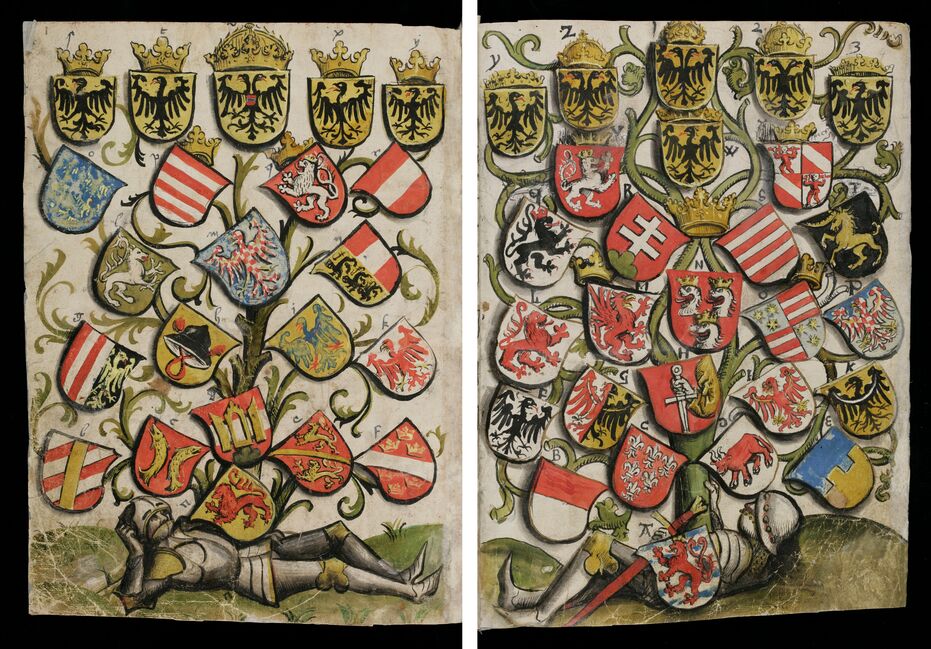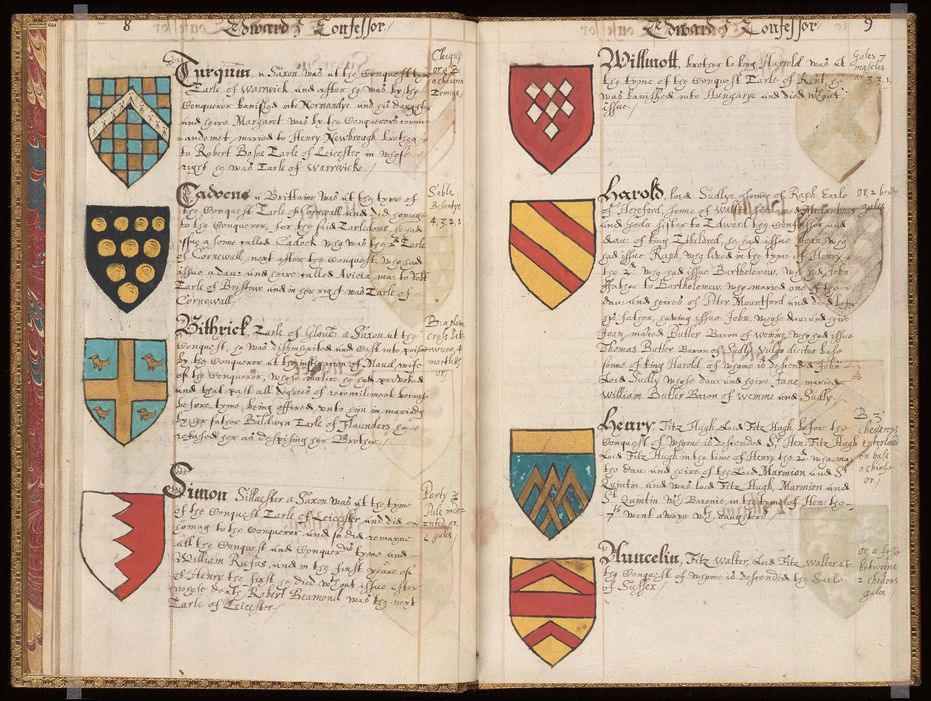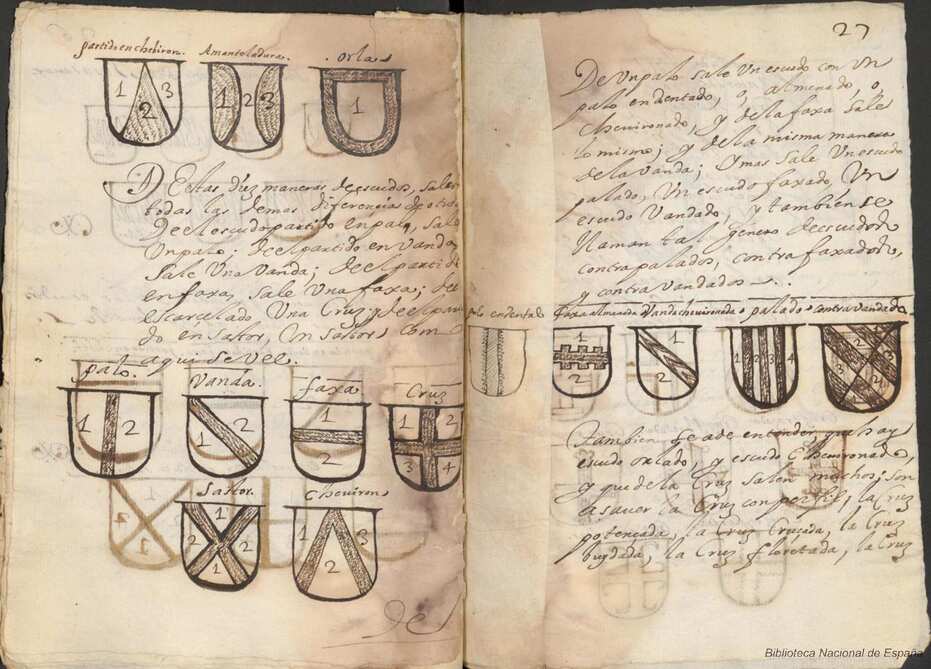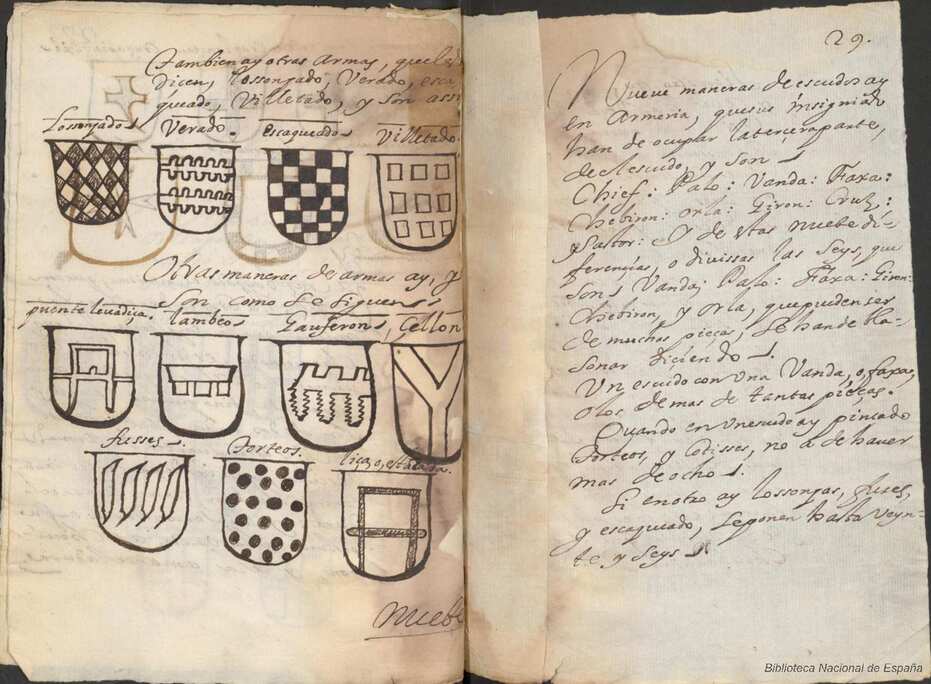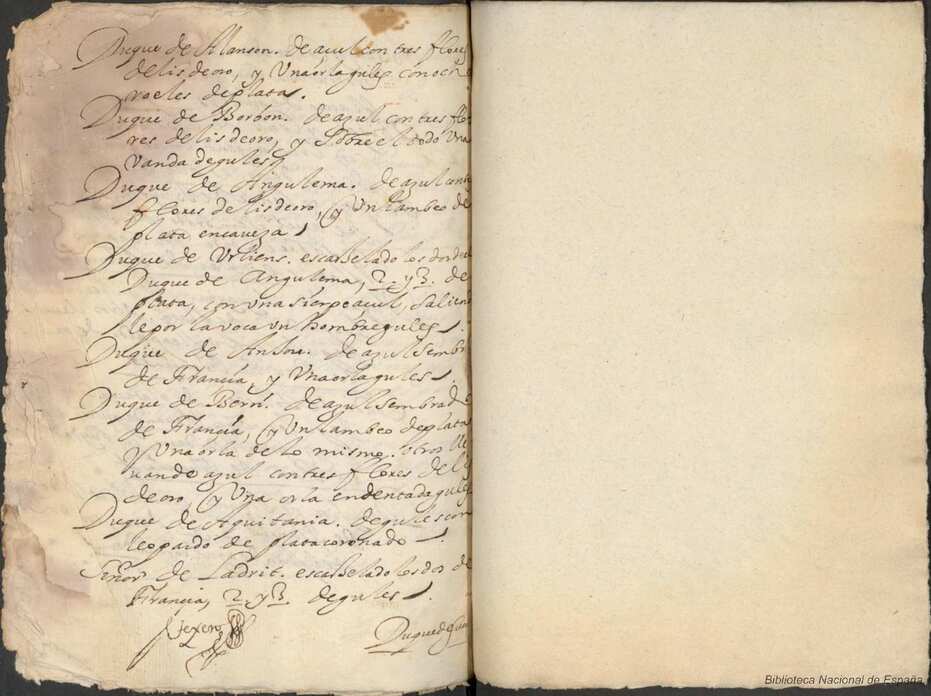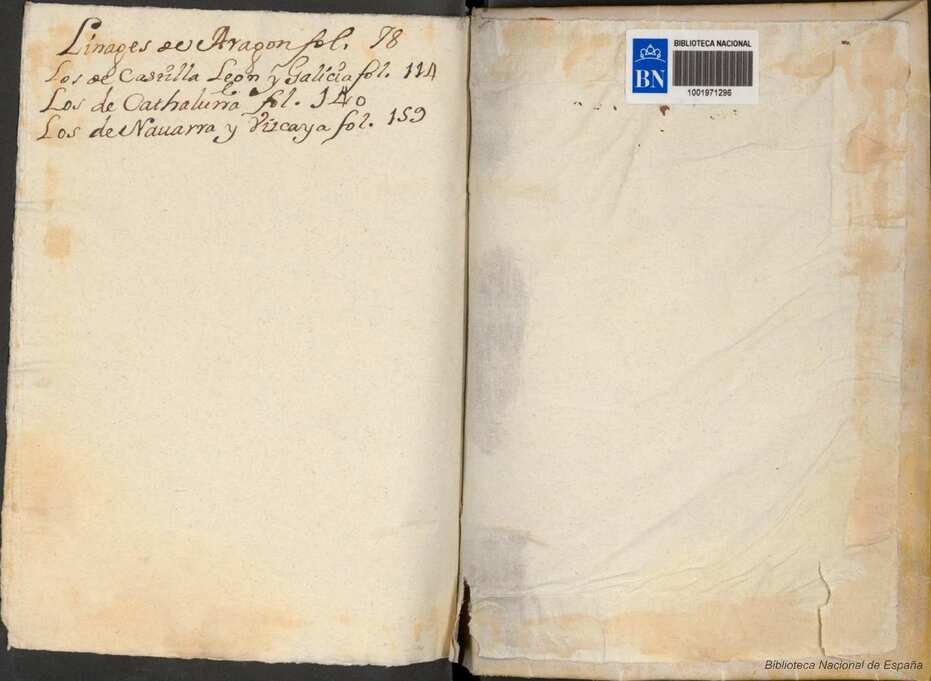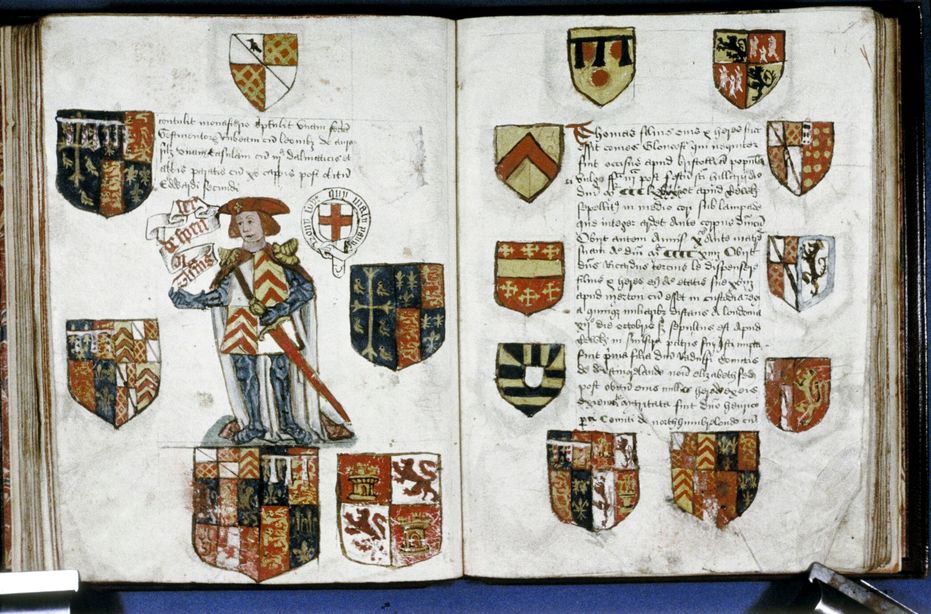Manuscript


![Ver [Aix-en-Provence; 1351] en referencias bibliográficas. Libro abierto, hojas de plata, filo de oro, guardas de gules, tapas de sable.](../css/Libro.Bibliografia.png)
Aix-en-Provence; 1351
Aix-en-Provence, «Délibérations municipales d'Aix-en-Provence», Archives Municipales; key BB 28, 1351
Bibliographical reference of century XIV.
Classification: Manuscript and Latin language.
The author is Aix-en-Provence.
Bibliographical reference mentioned in the following article:
External resource:


![Ver [Alfonso X of Castile; 1265] en referencias bibliográficas. Libro abierto, hojas de plata, filo de oro, guardas de gules, tapas de sable.](../css/Libro.Bibliografia.png)
Alfonso X of Castile; 1265
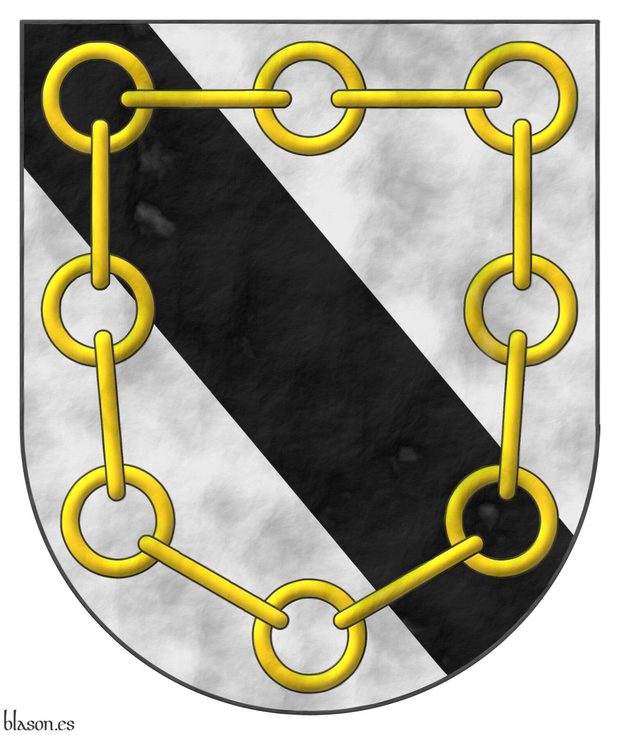
Alfonso X of Castile, The Wise, «The Seven-Part Code», its estimated completion year is 1265.
This is the copy I can consult, as it is available in the Hispanic Digital Library, it is a manuscript measuring 42 by 30 centimeters that once belonged to Álvaro de Zúñiga y Guzmán, first Duke of Arévalo, which later came into the possession of the Catholic Monarchs, initially Queen Isabella I of Castile, and after her death, King Ferdinand reclaimed it for the price of 5,251 maravedis. The original is housed in the National Library, in display case 4/6.
This copy, in addition to its numerous capital letters, has 8 illustrated pages, which according to its subsequent hand-numbering in pencil are:
- Page 6, among its illustrations can be seen 2 coats of arms of the Zúñiga family «Argent, a bend Sable, over all, a chain in orle Or», in this case formed by 16 links, 8 round and 8 more elongated placed in profile.
- Pages 106 and 191, on the latter can be seen a curious bishop-lizard climbing.
- Pages 294 and 331, on the 2nd at the bottom, a maiden is seen walking a monkey to relieve itself and to her right a fight of men with beast bodies.
- Page 379 and on its previous unnumbered page, and finally, on page 415 which begins with a tournament where the 2nd knight bears the ancient arms of France «Azure, semy of fleurs de lis Or».
The coat of arms that illustrates this bibliographic reference is that of Álvaro de Zúñiga y Guzmán. For the creation of his chain, I followed the illustration of his 2 coats of arms on the already mentioned page 6 of this manuscript.
It is one of my favorite manuscripts and, perhaps, the one with which I have created the most things.
Bibliographical reference of century XIII.
Classification: Castilian language, Manuscript and In color.
Author: Alfonso X of Castile.
Bibliographical reference mentioned in the following article:
External resources:
- National Library of Spain.
- Indirect access to the Library of Congress of the United States of America.
- Direct access to the Library of Congress of the United States of America.
Internal resources: AlfonsoXDeCastilla1265.7Partidas.10642.pdf.


![Ver [Anonymous; 1800a] en referencias bibliográficas. Libro abierto, hojas de plata, filo de oro, guardas de gules, tapas de sable.](../css/Libro.Bibliografia.png)
Anonymous; 1800a
Anonymous, «Armerías de España», 124 double pages, title in the page 9, provenance Duke of Osuna and Infantado, 1800.
Content
The book has no index and its content, written by hand, is as follows:
- Pages 1 through 8 are blank.
- On page 9, title, the letter A begins and surnames Abarca, Abendaño, Abeo, Ablitas and Abrego in large handwritten and the blazon in small handwritten (except for the end of the book on page 123, the unknown author seems to write more about surnames than about lineages).
- On page 10, the surnames with the letter A continue and their blazon both in small handwritten.
- On page 23, the letter B begins, its surnames and their blazons, for example, the Barrasas, in the page 25, «Or, six Lions proper, combatant».
- On page 30, the letter C begins, it is followed by the letter Z on page 42, 29 surnames with Z was written before the letter D and Cocas and Cuacas, with the letter C, are inserted inside the letter Z.
- It follows in alphabetical order of surnames from page 46, where the letter D begins, to page 97 with the letter S, including in the S the surname Sánchez on page 99, as a lineage will be included at the end of the book, and it follows with the letter S until the page 104.
- On page 105 the letter T begins, surname Tabixas, Taboadas, Tafuxes, ...
- On page 109 jump from the letter T to the letter V, with the surnames Vacas, Vadillos,... and skipping the letter U.
- On page 119, it returns from letter V to U, in an unordered manner and without including the title with the capital letter U.
- On page 120, begins the letter X and also the letter Y.
- On page 122, the letter Z and only 3 additional surnames with Z, recall that the majority of the surnames with Z were included after the letter C.
- On page 123 he returns to the surname Sánchez by testimony of Pedro de Soto owner of the books of Armory of Spain of Andreas Heredia, King of Arms, and finally the unknown author copies the text for the surname Sánchez, those who were «hijosdalgos, en Cangas de Gobadonga» ~ Covadonga of Asturias and ends with a poem of 8 verses. Andreas Heredia, also known as Andrés Heredia, was King of Arms during the reign of Philip III of Spain, [Nieto y Cortadellas, R.; 1957a; Page 4]
- Beginning on page 124 are blank.
Bibliographical reference of century XVIII.
Classification: Manuscript, Armorial roll, In black and white and Castilian language.
The author is unknown.
Bibliographical reference mentioned in the following article:
External resources:
- Detail of this Armorial in the National Library of Spain.
- Bibliographic record of the National Library of Spain.
- Scanned Armorial in the National Library of Spain.
Internal resources: Osuna1800.ArmeriaEspaña.Manuscrito.pdf.


![Ver [Avilés, T. de; XVI] en referencias bibliográficas. Libro abierto, hojas de plata, filo de oro, guardas de gules, tapas de sable.](../css/Libro.Bibliografia.png)
Avilés, T. de; XVI
Tirso de Avilés, continued by Martín de Bolea y Castro, «Roll of arms», 3 volumes, Volume I, coats of arms of kings, princes and grand titles, 208 hand-numbered pages in Roman numerals, Volume II, coats of arms of noble and private titles, 129 hand-numbered pages in Arabic numerals, Volume III, coats of arms of popes, cardinals, archbishops and bishops, 185 hand-numbered pages in Arabic numerals, in the National Library of Spain, signatures Mss/12550 V.1, Mss/12551 V.2 and Mss/12552 V.3, it is estimated from the XVI century.
Bibliographical reference of century XVI.
Classification: Manuscript, Armorial roll, In color and Castilian language.
Author: Avilés, Tirso de.
Bibliographical reference mentioned in the following article:
External resources:
- Detail of this armorial in the National Library of Spain.
- Bibliographic record of the National Library of Spain.
- Scanned Armorial in the National Library of Spain.
Internal resources: Volume I AvilesTdeXVI.11.Tomo01.pdf, Volume II AvilesTdeXVI.11.Tomo02.pdf and Volume III AvilesTdeXVI.11.Tomo03.pdf.
Credits: This book belongs to the Biblioteca Nacional de España. License Creative Commons CC-BY. You may share, transform and create from images in the public domain that are accessible in the Hispanic Digital Library.


![Ver [Becher, C.; Gamber, O.; 1986] en referencias bibliográficas. Libro abierto, hojas de plata, filo de oro, guardas de gules, tapas de sable.](../css/Libro.Bibliografia.png)
Becher, C.; Gamber, O.; 1986
Charlotte Becher and Ortwin Gamber, «Die Wappenbücher Herzog Albrechts VI. von Österreich: Ingeram-Codex der ehem, Bibliothek Cotta, Volume 1», editado por Böhlau Verlag Wien, 178 pages, ISBN 3-205-05002-9 y 978-32-05050-02-5, Vienna, Cologne, Graz, 1986.
Dedicated exclusively to the study and analysis of the armorial [Ingeram, H.; 1459].
Bibliographical reference of century XX.
Classification: German language, Manuscript, Armorial roll and In color.
Authors: Becher, Charlotte and Gamber, Ortwin.
Bibliographical reference mentioned in the following article:
External resource:


![Ver [Bergshammars; 1440] en referencias bibliográficas. Libro abierto, hojas de plata, filo de oro, guardas de gules, tapas de sable.](../css/Libro.Bibliografia.png)
Bergshammars; 1440
Anonymous, «Roll of arms», roll of arms manuscript called Bergshammars, written, emblazoned and edited in Brabant, Burgundian Netherlands, during the years 1440-1456, 493 pages numbered later in pencil, contains coats of arms of several European kingdoms, on page 488 the year 1553 seems to be written, Brabant, ca 1440.
Bibliographical reference of century XV.
Classification: Armorial roll, Manuscript and In color.
The author is anonymous.
The following articles cite this bibliographic reference:
External links:
Internal resources: Bergshammars1440.33.Video.Manuscript.SchubertSymphony4.mp4 a video lasting 7 minutes and 11 seconds, sound track Symphony No. 4 in C minor, D 417, called Tragic, composed by Franz Schubert in April 1816, when he was 19 years old.


![Ver [Calvo, P.; 1501] en referencias bibliográficas. Libro abierto, hojas de plata, filo de oro, guardas de gules, tapas de sable.](../css/Libro.Bibliografia.png)
Calvo, P.; 1501
Pedro Calvo, notary and alderman of the city of Calatayud, «Libro de cuentas de la ciudad de Calatayud» ~ «Account book of the city of Calatayud», literal title, «Libro dela data fecha por pedro calvo notao Regidor dela ciutat de Calatayut enel anyo de mil Quinientos y uno», manuscript restored with cover, back cover and Mudejar style binding, 2 blank pages behind the cover and the back cover, 76 inner pages of 300 x 230 mm, of which 7 could be in white and in even position, 3 in white among the first 20 pages, 1 blank towards the middle of the book and another 3 blank between the last 20 pages, final annotation with the term «cabreo», Calatayud, 1501.
Bibliographical reference of century XVI.
Classification: Manuscript, In black and white and Castilian language.
Author: Calvo, Pedro.
External resources:
- Documents and archives of Aragon, DARA Medieval, registry of the book and link to the image included here.
- Name of the Latin written after the fall of the Roman Empire and during the Middle Ages.
Internal resources: CalvoP1501.CalatayudDataOriginal.pdf book as a sequence of available pages and CalvoP1501.CalatayudDataPaginado.pdf book recomposed in sequence of odd and even pages, with blank pages inserted to recover lost sequences.


![Ver [Charles' Roll; 1285] en referencias bibliográficas. Libro abierto, hojas de plata, filo de oro, guardas de gules, tapas de sable.](../css/Libro.Bibliografia.png)
Charles' Roll; 1285
«Charles's Roll», containing 486 painted coats of arms, it is an English roll of arms dating from c. 1285.
Charles' Roll, housed in the Society of Antiquaries, London, and cataloged as MS517, is a 15th-century English roll of arms, originally created around 1285, containing 486 painted coats of arms. The antiquary James Robinson Planché identified «Charles's Roll» as a copy of a mid-13th-century roll, British Library, Harley MS 6589, featuring nearly 700 coats of arms, drawn by Nicholas Charles, Lancaster Herald, in 1607. Charles mentioned that the original roll had been lent to him by the Norroy King of Arms.
Bibliographical reference of century XIII.
Classification: Armorial roll, Manuscript and In color.
The author is unknown.
Bibliographic reference mentioned in the following articles:


![Ver [Cnut Gospels; 1020] en referencias bibliográficas. Libro abierto, hojas de plata, filo de oro, guardas de gules, tapas de sable.](../css/Libro.Bibliografia.png)
Cnut Gospels; 1020
Anonymous, «The Cnut Gospels», call number Royal MS 1 D IX, illuminated manuscript, Canterbury, circa 1020.
Contents and history
This manuscript, containing the Four Gospels, dates from the early 11th century. It is believed to have belonged to Christ Church, Canterbury, and may have been created there. It is named after Cnut, King of England, who reigned from 1016 to 1035, due to an added text in Old English that names Cnut and his brother Harold as brothers of the monastery.
Despite its royal associations, the manuscript only entered the Old Royal Library in the early 17th century, when Henry Frederick, Prince of Wales, acquired the library of John, 1st Baron Lumley.
Decoration and inscription details
The manuscript features full-page decorations at the beginning of each Gospel, with initials illuminated in gold, and lush stylized leaves in the borders, characteristic of late Anglo-Saxon decoration. For example, the border of the Gospel of Mark includes stylized leaves and embedded roundels of saints, and the incipit page for the Gospel of John is particularly notable for its decorated frame and gold initials.
Bibliographical reference of century XI.
Classification: Manuscript, English language and In color.
The author is unknown.
The following article cites this bibliographic reference:


![Ver [Cofradía de Santiago; Century XIV] en referencias bibliográficas. Libro abierto, hojas de plata, filo de oro, guardas de gules, tapas de sable.](../css/Libro.Bibliografia.png)
Cofradía de Santiago; Century XIV
Anonymous, «Libro de la Cofradía de Caballeros de Santiago de la Fuente», held by the Brotherhood of Santiago, Burgos Cathedral, manuscript, illustrated, 94 leaves, 21 missing, folio size, 29 x 21 centimeters, Burgos, 1338-1636.
Introduction
The illuminated manuscript chronicles the history and membership of the Brotherhood of Knights of Santiago in Burgos. Founded in 1338 during the reign of King Alfonso XI, as indicated by the preamble to the Rule on folio 27 verso, the Brotherhood was composed of members of the social and political elite of Burgos. The manuscript spans several centuries, primarily from the 14th to the 17th century.
The first 13 folios include a record of four deeds dating from 1396 to 1415, all related to the financial dealings of the Brotherhood.
Folio 14 marks the beginning of the original Rule of the Brotherhood, adorned with an illuminated initial «E» and a vignette of Christ flanked by saints and angels.
Portraits and illumination
The manuscript includes a list of the members, known as «cofrades» in Castilian, alongside their portraits and coats of arms. The book contains 295 portraits, added over time, with the last one dated to 1636.
The knights depicted in the manuscript held significant roles in the city, such as mayors, scribes, and other high offices. Many of the knights' families, like the Camargos from France and the Sanchestels from England, are noted for their diverse origins.
The portraits begin on page 21, initially with four to a page until folio 44, after which the number decreases to three, two, and eventually single figures per page.
Binding and preservation
The manuscript is bound in red leather with gold fillets and clasps, a 19th-century binding aimed at preserving the parchment pages. Originally, it had 94 leaves, but 21 are now missing, as noted in a contemporary annotation at the front.
Bibliographical reference of century XIV.
Classification: Manuscript, Armorial roll, Castilian language and In color.
Author: anonymous.
The following articles cite this bibliographic reference:
Internal resources: 86 images in JPEG format.


![Ver [Cró, J. do; 1509] en referencias bibliográficas. Libro abierto, hojas de plata, filo de oro, guardas de gules, tapas de sable.](../css/Libro.Bibliografia.png)
Cró, J. do; 1509
João do Cró, «Livro do Armeiro-Mor», roll of arms manuscript, written and emblazoned during the reign of Manuel I of Portugal, 161 pages, it is in the Torre do Tombo National Archive, ca 1509.
Bibliographical reference of century XVI.
Classification: Manuscript, Armorial roll, In color and Portuguese language.
Author: João do Cró.
Bibliographic reference mentioned in the following articles:
External link:
Internal resources: CroJdo1509.LivroDoArmeiroMor.02.Comentado.Desordenado.pdf 277 pages and Facsimile edition on paper.


![Ver [Galdiano L.; Century XVII] en referencias bibliográficas. Libro abierto, hojas de plata, filo de oro, guardas de gules, tapas de sable.](../css/Libro.Bibliografia.png)
Galdiano L.; Century XVII
Anonymous, «Arms and Lineages of Spain», Lázaro Galdiano Foundation, call number 405, manuscript, illustrated, 330 pages, 29 x 22 centimeters, century XVII.
Content and notes
This manuscript contains heraldic descriptions and illustrations of coats of arms, with a coat of arms at the end of each lineage. The coats of arms are painted at the end, and the title of the next lineage is written so close, sometimes physically attached, that one might believe that the title under the coat of arms belongs to the lineage of the coat of arms, when it is actually the coat of arms of the previous lineage. The initial index occupies 20 pages, then the folios are numbered r, recto, up to 194, folio 195 is numbered, its title is «of the Medranos» and it contains an unusual coat of arms, by another hand and without tinctures, folio 196 is numbered and blank, and the final 14 folios are written in another style, and they are a small compendium of heraldic concepts. I understand that the Medrano family might have owned this manuscript for a time and added their lineage at the end of this armorial.
Physical condition and binding
Some leaves have been restored and reinforced at the margins, and the manuscript is in good condition. There is an annotation in manuscript on the verso of the first guard leaf: «8, 1500, F».
A dry stamp is present on the second guard leaf: «Obrador De Encuadernaciones De Antonio Menard. 15 Cervantes 15 Madrid». The manuscript is bound in vellum with a gilded top edge.
Manuscript index
- Alphabetical table of lineages.
-
Armorial of kings:
- Of the arms of Prester John.
- Follow the arms and blazon of Jerusalem.
- Of the branches of the Kingdom of Cyprus and its King.
- Arms of the German Empire.
- Of the King of Hungary.
- The arms of Frisia and why it lost the name of Kingdom.
- Bohemia.
- Arms of the King of Poland and León.
- Of the kingdom of Sweden and Gothia.
- Of the kingdom of Norway.
- Of the King of Gelandia.
- Of the King of Scotland.
- Arms of England.
- Of the King of Hibernia.
- Arms of Rome.
- Arms of the King of Naples.
- Of the Duke of Milan.
- Of the King of Sicily.
- Of the King of France.
- Those who populated Spain are written.
- Of the Kings of Navarra.
- Of the King of Aragón.
- Of the King of Portugal.
- How the kings of Castilla began.
-
Armorial of lineages:
- Of the Manuels.
- Of the De la Cerda.
- Of the Enríquez.
- Of the Duke of Va Hermosa Don Alonso de Aragón.
- Of the Castillas.
- Of the Guzmanes.
- Of the Flores.
- Of the Ponces de León.
- Of the Carrillos.
- Of the Manriques.
- Of the De Albornoz.
- Of the Riveras.
- Of the Portugals.
- Of the Haros.
- Of the Lara lineage.
- Of the Guevaras.
- Of the Mendozas.
- From where the Hurtados come.
- Of the foundation and surname of Ayala.
- Of the Velascos.
- Of the De Castros.
- Of the Herreras.
- Of the De la Vegas.
- Of the De Tovars.
- Of the Sarmientos.
- Of the Estunigas.
- Of the Añayas.
- Of the Cerezos.
- Of the Heredias.
- Of the Aguilars.
- Of the Pachecos.
- Of the Osorios lineage.
- Another difference of arms.
- Pimentels.
- Of the Avellanedas.
- Of the Bracamontes.
- Of the Cueva.
- Of the Toledos.
- Another difference of arms of Toledo from the Garcías.
- Of the Barrosos.
- Of the Silvas.
- Of the Palomeques.
- Of the Gaitanes.
- Of the Gudiels.
- Of the Sandovals.
- Of the Niños.
- Of the Cervatos.
- Of the Fonsecas.
- Of the Coroneles.
- Of the Avalos.
- Of the Lunas.
- Of the Torquemadas.
- Of the Carvajales.
- Of the Rivadeneiras.
- Of the Padillas.
- Of the Valderrábanos.
- Of the Aguayos.
- Of the Zapatas.
- Of the Mirandas.
- Of the De Acuñas.
- Of the Arellanos.
- Of the Castañedas.
- Of the Quiñones.
- Of the Cornados.
- Of the Cervantes.
- Of the Loaysas.
- Of the Cisneros.
- Of the Dazas.
- Of the Córdobas.
- Of the Matas.
- Of the Aceves.
- Of the Cuellos.
- Of the Villarrueles.
- Of the De Biveros.
- Of the De Rojas.
- Of the De Orozcos.
- Those called from Bizcaya.
- Of the Sorvas.
- Of the Maldonados.
- Of the Fajardos.
- Of the Contreras.
- Of the Moscosos.
- Of the Mejías.
- Of the Sosas.
- Of the Figueroas.
- Of the Barahonas.
- Of the Montoyas.
- Of the Alarcóns.
- Of the La Torre.
- Of the Ludos.
- Of the Moyas.
- Of the Ángulos.
- Of the Calatayuds.
- Of the Gaonas.
- Of the Mendaños.
- Of the Beneros.
- Of the Londoños.
- Of the Quevedos.
- Of the Ulloas.
- Of the Quirogas.
- Of the Liras.
- Of the Meneses.
- Of the Girones.
- Of the constable Miguel Lucas.
- Of the Prados.
- Of the Salazars.
- Of the Solórzanos.
- Of the Cárdenas.
- Of the Biedmas.
- Of the Obregóns.
- Of the Bustos.
- Of the Almansas.
- Of the Puerto Carreros.
- Of the Sartes.
- Of the Carates.
- Of the Aljofríns.
- Of the Barrientos.
- Of the Reinosos.
- Of the Locanas.
- Of the Chacones.
- Of the Pantojas.
- Of the Carranzas.
- Of the Pereas.
- Of the Vanegas.
- Of the Lujanes.
- Of the Calderones.
- Of the La Cadena.
- Of the Delgadillos.
- Of the Clavijos.
- Of the Grajedas.
- Of the Ávila.
- Of the Lisones.
- Of the De Mesas.
- Of the Las Ruelas.
- Of the Rapados.
- Of the Villandrandos.
- Of the Luzones.
- Of the Torres.
- Of the De Soliez.
- Of the Herrezuelos.
- Of the Pavía.
- Of the Berrios.
- Of the Baruas.
- Of the Benavides.
- Two differences of arms.
- Of the Narváez.
- Of the Robles.
- Of the De Ñero.
- Of the Mojicas.
- Of the Bacanes.
- Of the Bastoncillos.
- Of the Bocanegras.
- Of the Castillos.
- Of the De Cañizares.
- Of the Cerezuela.
- Of the Dorantes.
- Of the De Estrada.
- Of the Escobares.
- Of the Salcedos.
- Of the De Inestrosa.
- Of the De Isla.
- Of the Illanes.
- Of the Jaravas.
- Of the Oñez.
- Of the Cuadrados.
- Of the Pardos.
- Of the Penalosas.
- Of the Porras.
- Of the Muñizes.
- Of the Ruecos.
- Of the Sotos.
- Of the Romos.
- Of the Salcedos.
- Of the Tenorios.
- Of the Valdeses.
- Of the Vallejos.
- Of the Villagómez.
- Of the Bargas.
- Of the Verdejos.
- Of the Marinos.
- Of the Morales.
-
Added lineage and coat of arms:
- Of the Medranos.
-
Compendium of heraldic concepts:
- First preamble.
- The rule of heraldry follows.
- Second preamble.
- Third preamble.
- Final fourth preamble.
- The meaning of gold.
- The meaning of silver.
- The meaning of blue.
- The meaning of gules, which is red.
- Sable, which is black.
- The meaning of vert, which is green.
- The meaning of purpure, which is purple.
Bibliographical reference of century XVII.
Classification: Manuscript, Armorial roll, Castilian language and In color.
Author: anonymous.
Bibliographical reference mentioned in the following article:
Internal resources: GaldianoLXVII.ArmasLinajesEspaña.pdf PDF format.


![Ver [Gamonal; Century XVI] en referencias bibliográficas. Libro abierto, hojas de plata, filo de oro, guardas de gules, tapas de sable.](../css/Libro.Bibliografia.png)
Gamonal; Century XVI
Anonymous, «Libro en que se pintan los cavalleros cofrades de la Cofradía de Nuestra Señora de Gamonal», National Library of Spain, call number Mss/22258, manuscript, illustrated, 4+((28-3)*2+1)+2 = 57 pages, 27 folios, 30 x 23 centimeters, Burgos, 1575-1600.
Content and notes
This manuscript contains 46 full-page, mannerist-style portraits of equestrian knights, members of the Cofradía de Nuestra Señora de Gamonal, with their coats of arms, painted in color and illuminated with gold and silver, though some remain unfinished. Below some of the images, the name of the knight is inscribed. An annotation on the cover reads: «Jusepe de Aiala pintose en [B]urgos» indicating the possible artist. The manuscript has been foliated in ink at the lower right corner and in pencil at the upper right, modernized. Some notes in 19th-century handwriting are also present.
Bibliographical reference of century XVI.
Classification: Manuscript, Armorial roll, Castilian language and In color.
The author is anonymous.
External resource:
Internal resources: GamonalXVI.Armorial.Ecuestre.pdf PDF format.


![Ver [Godinho, A.; 1521] en referencias bibliográficas. Libro abierto, hojas de plata, filo de oro, guardas de gules, tapas de sable.](../css/Libro.Bibliografia.png)
Godinho, A.; 1521
António Godinho, «Livro da nobreza e da perfeição das armas dos reis cristãos e nobres linhagens dos reinos e senhorios de Portugal» ~ «Book of Nobility and Perfection of the Arms of Christian Kings and Noble Lineages of the Kingdoms and Lordships of Portugal», 1 book, parchment, 66 pages, 4 coats of arms per page, 43 x 32 centimeters, ca. 1521.
António Godinho was a clerk of the Chamber of King John III, but the codex was started during the time of King Manuel (ca. 13 December 1521). I use the year 1521 only for the purpose of creating the book key.
I think the book contains 263 illuminated coats of arms, including those of the King of Portugal, the King of Castile, the King of Aragon, and others. It was restored and returned to the archive on the 21st of June, 1904.
Bibliographical reference of century XVI.
Classification: Manuscript and Armorial roll.
The author is Godinho, António.


![Ver [Grünenberg, K.; 1480] en referencias bibliográficas. Libro abierto, hojas de plata, filo de oro, guardas de gules, tapas de sable.](../css/Libro.Bibliografia.png)
Grünenberg, K.; 1480
Konrad Grünenberg, «Das Wappenbuch Conrads von Grünenberg, Ritters und Bürgers zu Constanz», Münchener DigitalisierungsZentrum, Bayerische Staatsbibliothek, call number Cgm 145, 182 leaves, parchment, 37 x 31 centimeters, manuscript in German, circa 1480.
Contents
The «Wappenbuch» by Konrad Grünenberg is a splendid manuscript featuring several hundred colored coats of arms. Written on parchment, this manuscript is believed to be a contemporary copy of the original version on paper, which was completed in 1483 and is currently preserved in Berlin. This manuscript was once part of the Bavarian dukes' library and was likely owned by Duke Wilhelm IV of Bavaria, 1493-1550. It depicts coats of arms of barons, dukes, margraves, archbishops, free cities and towns, and orders of knights from across Germany, as well as royal coats of arms from various European kingdoms.
Provenance
The manuscript is linked to Konrad Grünenberg, a prominent burgher and knight from Konstanz, a town on Lake Constance in southwestern Germany. Although the exact dates of his birth and death are unknown, Grünenberg was first mentioned as a builder in 1442. He devoted much of his life to heraldry, resulting in the creation of this armorial that bears his name. This specific copy is one of several made from Grünenberg's original autograph.
Creative Commons
The manuscript is fully digitized and available for study, and is licensed under the Creative Commons Attribution-NonCommercial-ShareAlike 4.0 International.
Bibliographical reference of century XV.
Classification: Armorial roll, Manuscript, German language and In color.
The author is Grünenberg, Konrad.
External resources:
Internal resources: GrunenbergKonrad1480.mp4 Video in MP4 format and GrunenbergKonrad1480.pdf Armorial in PDF format.


![Ver [Heralds' Roll, T.; 1280] en referencias bibliográficas. Libro abierto, hojas de plata, filo de oro, guardas de gules, tapas de sable.](../css/Libro.Bibliografia.png)
Heralds' Roll, T.; 1280
«The Heralds' Roll», containing 697 painted coats of arms, it is an English roll of arms dating from c. 1280.
In The Fitzwilliam Museum, Cambridge, with code MS297, there is a copy of the 15th century.
Bibliographical reference of century XIII.
Classification: Armorial roll, Manuscript and In color.
The author is anonymous.
Here are the articles quoting this reference:
External links:

![Ver [Ingeram, H.; 1459] en referencias bibliográficas. Libro abierto, hojas de plata, filo de oro, guardas de gules, tapas de sable.](../css/Libro.Bibliografia.png)
Ingeram, H.; 1459
Hans Ingeram, «Ingeram Codex», 142 pages, 1459.
The first owner of this armorial was Archduke Albert VI of Austria. Hans Ingeram included in each page of his book from 1 to 6 coats of arms, he dedicated the initial part to the Habsburg coats of arms, to imaginary coats of arms and to the coats of arms of European kingdoms, generally using 4 coats of arms per page, and dedicated the final 2/3 of its content to depicting 6 coats of arms per page of the lower German nobility, especially nobles belonging to a special type of «associations» whose purpose was the organization of tournaments. A monograph on this armorial can be consulted in [Becher, C.; Gamber, O.; 1986].
Bibliographical reference of century XV.
Classification: Manuscript and Armorial roll.
The author is Ingeram, Hans.
Here are the articles quoting this reference:
External links:


![Ver [Lutzelbourg, N. de; 1530] en referencias bibliográficas. Libro abierto, hojas de plata, filo de oro, guardas de gules, tapas de sable.](../css/Libro.Bibliografia.png)
Lutzelbourg, N. de; 1530
Nicolas de Lutzelbourg, lord of Fléville and captain of Nancy, «Roll of arms», sixteenth century (the author lived between 1485? and 1547), manuscript in French on parchment, with 230 pages numbered later with pencil the odd pages from 1 to 115, 29 x 21 cm, Bibliothèque-Médiathèque of Nancy digitized, source of the images with open license.
Video of 120 seconds composed for the Biblioteca Genealógica, Heráldica y Nobiliaria. Music by Georg Philipp Telemann (1681, 1767), Concerto for 4 Violins No. 2, TWV 40: 202, II. Grave, interpreted by Viola Viva, with Creative Commons license of Attribution and ShareAlike.
Content examples: Scotland on pages 28, 29 and 30 with 61 coat of arms; Aragon on page 33 with 11 coat of arms; Castile and Leon on page 35 with 8 coat of arms; Navarre on page 36 with 1 coat of arms; and Portugal on pages 37 and 38 with 27 coat of arms.
Bibliographical reference of century XVI.
Classification: Manuscript, Armorial roll, French language and In color.
The author is Lutzelbourg, Nicolas de.
Bibliographic reference mentioned in the following articles:
External links:
- Manuscript's record in the Bibliothèque-Médiathèque of Nancy.
- Manuscript's pages in the Bibliothèque-Médiathèque of Nancy.


![Ver [Ma, F.; Century XVI] en referencias bibliográficas. Libro abierto, hojas de plata, filo de oro, guardas de gules, tapas de sable.](../css/Libro.Bibliografia.png)
Ma, F.; Century XVI
Anonymous, «Genealogy of the Mǎ Family, 馬民家记», manuscript, from the late Ming to early Qing dynasty, 6 volumes, volume 1, 102 pages, volume 2, 304 pages, volume 3, 242 pages, volume 4, 202 pages, volume 5, 100 pages, and volume 6, 178 pages, total 1128 pages, dated between 1600 and 1735, circa 1735.
Disclaimer
These comments has been writen based on my limited knowledge of Classical Chinese. As such, it may contain inaccuracies or errors. I apologize for any errors and welcome corrections from those more knowledgeable in the subject. It is important to note that, although the manuscript is written in Classical Chinese, some characters in theses comments are in Simplified Chinese.
Cover
-
The title of the work on the cover is
«馬民家记», where:
- «民家记» means Genealogy, and
- «馬» is Mǎ in pīnyīn, it is the family name, literally meaning Horse.
-
The character «馬» is an ideogram, representing a galloping horse:
- the head faces left,
- three horizontal lines to the right of the head represent the mane blowing in the wind,
- the four vertical strokes below represent the legs, and
- the curved stroke at the bottom right symbolizes the tail.
-
Beneath the title on the cover,
we read, from top to bottom and right to left,
as is typical in traditional Chinese:
«六写全» where:
- «六» means six,
- «写» means book, it hasn't plural, books for us, and
- «全» can be translated as complete.
Four generations
The title might suggest it is just the family tree of the Mǎ family, but it is actually a chronicle of the history of a lineage over four generations. Therefore, although it is dated between 1600 and 1735, it is likely written closer to 1735.
The manuscript narrates the deeds and actions of four generations of the Mǎ family from the city of Liáoyáng in northeastern China:
- Great-grandfather: Mǎ Mingpei (1600–1666),
- Grandfather: Mǎ Xiongzhen (1634–1677),
- Father: Mǎ Shiji (1650–1714),
- Son: Mǎ Guozhen (1666–1720).
It seems to be a story of ascent and descent:
- The great-grandfather was a significant figure.
- The grandfather was even more prominent, eventually assassinated, and posthumously awarded titles and an honorary name, «Wenyi».
- The father and son, though important, did not reach the heights of their predecessors.
This manuscript contains official titles, title grants, imperial praises for their actions, historical events, and also the poetic and literary works of the four generations.
Scanned for readability by Westerners
The correspondence between these 6 volumes and the 9 scaned PDF files is as follows:
- Volume 1: PDF 1.
- Volume 2: PDF 2 and PDF 3.
- Volume 3: PDF 4 and PDF 5.
- Volume 4: PDF 6 and PDF 7.
- Volume 5: PDF 8.
- Volume 6: PDF 9.
The Chinese books are read: from back to front, from right to left, and from top to bottom.
The scanning process was done so that what would be the last pages of the book for us, and the first for the Chinese, are at the beginning of the PDF. The pages are scanned in pairs to be readable by Westerners: starting from page 2-1, read from right to left, with 1 blank, and continuing 4-3, 6-5, 8-9... until the end of the PDF file.
The Chinese script used in this manuscript is clear and legible compared to other documents from that era.
Pages
6 volumes:
- volume 1, 51*2 = 102 pages,
- volume 2, 65*2+87*2 = 304 pages,
- volume 3, 66*2+55*2 = 242 pages,
- volume 4, 48*2+53*2 = 202 pages,
- volume 5, 50*2 = 100 pages, and
- volume 6, 89*2 = 178 pages,
Bibliographical reference of century XVI.
Classification: Manuscript, Classical Chinese language and In black and white.
The author is anonymous.
External resources:
- Library of the Congress.
- Volume 2, initial part.
- Volume 2, final part.
- Volume 3, initial part.
- Volume 3, final part.
- Volume 4, initial part.
- Volume 4, final part.
- Volume 5.
- Volume 6.
Internal resources: MaFamiliaXVIII.01a.tapas.pdf Volume 1 PDF format, MaFamiliaXVIII.02a.tapas.pdf Volume 2, initial part, PDF format, MaFamiliaXVIII.02b.pdf Volume 2, final part, PDF format, MaFamiliaXVIII.03a.tapas.pdf Volume 3, initial part, PDF format, MaFamiliaXVIII.03b.pdf Volume 3, final part, PDF format, MaFamiliaXVIII.04a.tapas.pdf Volume 4, initial part, PDF format, MaFamiliaXVIII.04b.pdf Volume 4, final part, PDF format, MaFamiliaXVIII.05a.tapas.pdf Volume 5 PDF format and MaFamiliaXVIII.06a.tapas.pdf Volume 6 PDF format.
Bibliographical reference of century XVI.
Classification: Manuscript, Classical Chinese language and In black and white.
The author is anonymous.
External resources:
- Library of the Congress.
- Volume 2, initial part.
- Volume 2, final part.
- Volume 3, initial part.
- Volume 3, final part.
- Volume 4, initial part.
- Volume 4, final part.
- Volume 5.
- Volume 6.
Internal resources: MaFamiliaXVIII.01a.tapas.pdf Volume 1 PDF format, MaFamiliaXVIII.02a.tapas.pdf Volume 2, initial part, PDF format, MaFamiliaXVIII.02b.pdf Volume 2, final part, PDF format, MaFamiliaXVIII.03a.tapas.pdf Volume 3, initial part, PDF format, MaFamiliaXVIII.03b.pdf Volume 3, final part, PDF format, MaFamiliaXVIII.04a.tapas.pdf Volume 4, initial part, PDF format, MaFamiliaXVIII.04b.pdf Volume 4, final part, PDF format, MaFamiliaXVIII.05a.tapas.pdf Volume 5 PDF format and MaFamiliaXVIII.06a.tapas.pdf Volume 6 PDF format.


![Ver [Manesse; 1315] en referencias bibliográficas. Libro abierto, hojas de plata, filo de oro, guardas de gules, tapas de sable.](../css/Libro.Bibliografia.png)
Manesse; 1315
Anonymous, «Große Heidelberger Liederhandschrift», University Library of Heidelberg, call number Codex Palatinus Germanicus 848, 852 pages, numbered from folio 1 to folio 426 v and r each side, parchment, 35.5 x 25 centimeters, manuscript in Middle High German, circa 1300-1340.
Von Wengen, folio 300r
Contents
The «Codex Manesse», also known as the «Great Heidelberg Book of Songs», Codex Palatinus Germanicus 848, is the most comprehensive collection of ballads and epigrammatic poetry in Middle High German. The manuscript contains almost 6000 verses from 140 poets, making it a key source for medieval German lyrics. The manuscript is written in gothic letters by several hands and is famous for its glorious colorful full-page miniatures, each dedicated to one of the 137 poets. The miniatures illustrate the poets in idealized, courtly scenes and are considered a significant document of Gothic illumination from the Upper Rhine region. It is not an armorial, but some of the illustrations feature coats of arms, including helmets with their crests.
The Manesse family
This codex was completed around the year 1304, although some parts may have been added later, up until the mid-14th century. Therefore, an approximate date of 1315 is often used as a general reference for the codex in its most complete state. The author of the codex is not known in the modern sense of the word. However, its compilation and sponsorship are attributed to the Manesse family, a patrician family from Zurich, particularly Rudolf II Manesse and his son Rudolf III Manesse, who likely commissioned and financed the creation of the codex.
Ownership history
The early history of the manuscript is not well-documented, by the end of the 16th century, it was in the possession of the Swiss Calvinist Johann Philipp von Hohensax. In 1607, the codex was claimed by the Prince Elector Frederick IV and brought to Heidelberg. During the Thirty Years' War, the manuscript was taken into exile to avoid capture. After the death of Frederick V in 1632, the manuscript was auctioned and eventually found its way to the Royal Library in Paris, where it remained for 230 years. In 1888, the manuscript was returned to Germany after a complex exchange deal orchestrated by bookseller Karl Ignaz Trübner. It is now preserved in the University Library of Heidelberg.
Condition and preservation
The turbulent history of the «Codex Manesse» has left its mark, with many miniatures showing damage from color abrasions and ink corrosion. Due to its fragile condition, the original codex is kept in an air-conditioned safe and is rarely exhibited. Facsimile editions have been produced over the years, including a full-facsimile published by Insel Verlag in 1925-1927.
Exhibitions and legacy
The «Codex Manesse» has been the subject of numerous exhibitions, including a comprehensive display in 1988 and another during the 625th anniversary of the University of Heidelberg in 2010-2011. It remains one of the most precious treasures of the University Library of Heidelberg and a cornerstone in the study of medieval German literature and art.
Bibliographical reference of century XIV.
Classification: Manuscript, German language and In color.
Author: unknown.
External links:
Internal resources: Manesse1315.pdf Armorial in PDF format.


![Ver [Ortenburg; 1473] en referencias bibliográficas. Libro abierto, hojas de plata, filo de oro, guardas de gules, tapas de sable.](../css/Libro.Bibliografia.png)
Ortenburg; 1473
Anonymous, «Ortenburg Armorial», written and illuminated by various individuals in Bavaria, between 1466 and 1473.
This armorial likely contains coats of arms and flags of the «cuaterniones», groups of four, each representing different social groups within the Holy Roman Empire. It also illustrates the heraldic emblems of most Bavarian princes, nobles, territories, bishoprics, and prince-bishops. Although its execution is somewhat rudimentary, it remains a valuable resource on the heraldry of southern Germany in the late 15th century.
By 1534, the manuscript had passed into the hands of the Counts of Ortenburg, near Passau, where heraldic emblems of the Ortenburg family and their ancestors were added. It remained with the family until 1953, when it was sold to the Bavarian State Library, where it is now preserved.
Bibliographical reference of century XV.
Classification: Armorial roll, Manuscript, German language and In color.
The author is anonymous.
External resource:
Internal resources: Ortenburg1473.pdf Digital PDF version..


![Ver [Pérez de Vargas, J.; XVI] en referencias bibliográficas. Libro abierto, hojas de plata, filo de oro, guardas de gules, tapas de sable.](../css/Libro.Bibliografia.png)
Pérez de Vargas, J.; XVI
Juan Pérez de Vargas, «Nobiliario», 228 pages with 2 columns, index between pages 224 and 228 ordered by initial but unordered within each initial, 31 x 23 centímeters, kept in the National Library of Spain, signature Mss/3061, it is estimated from the XVI century.
Structure
It follows a fixed structure for each entry: the name of the lineage or person, a horizontal line of separation, a explanatory text, a horizontal line of separation, coat of arms with the with of the column and full-color, a horizontal final line. All of this within the columns, only coming out for some exterior decorations, which I especially like.
My collaboration with the National Library of Spain
I have collaborated with the Department of Manuscripts, Incunabula, and Rare Books of the National Library of Spain to correctly attribute the authorship of this 16th century manuscript armorial titled «Nobiliario», signature Mss/3061, to Juan Pérez de Vargas. It has been quite an honor.
Bibliographical reference of century XVI.
Classification: Manuscript, Armorial roll, In color and Castilian language.
Author: Pérez de Vargas, Juan.
External resources:
- Detail of this armorial in the National Library of Spain.
- Bibliographic record of the National Library of Spain.
- Scanned Armorial in the National Library of Spain.
Internal resources: Pages from 1 to 117 PerezDeVargasJXVI.11.Paginas.001.117.pdf and Pages from 118 to 235 PerezDeVargasJXVI.12.Paginas.118.235.pdf.
Credits: This book belongs to the Biblioteca Nacional de España. License Creative Commons CC-BY. You may share, transform and create from images in the public domain that are accessible in the Hispanic Digital Library.


![Ver [Raber, V.; 1548] en referencias bibliográficas. Libro abierto, hojas de plata, filo de oro, guardas de gules, tapas de sable.](../css/Libro.Bibliografia.png)
Raber, V.; 1548
Vigil Raber, «Armorial con 7244 escudos de armas», 903 pages of content, almost all color pages, 7244 coat of arms, 30 x 21 centimeters, at the Herzogin Anna Amalia Library, shelf code Fol 220, permanent identifier 1249054540, 1548.
Bibliographical reference of century XVI.
Classification: Armorial roll, Manuscript, In color and German language.
The author is Raber, Vigil.
External links:
- Record in the Herzogin Anna Amalia Library.
- Content in the Herzogin Anna Amalia Library.
- Content in the Bilder Server.


![Ver [Rodríguez de la Vega, A.; XVI] en referencias bibliográficas. Libro abierto, hojas de plata, filo de oro, guardas de gules, tapas de sable.](../css/Libro.Bibliografia.png)
Rodríguez de la Vega, A.; XVI
Alonso Rodríguez de la Vega, «Roll of arms of Spain», 377 hand-numbered pages in Arabic numerals, all coat of arms illustrations are only partially outlined and without tinctures, written according to the title page in the time of Emperor Charles V, in the National Library of Spain, signatures Mss/3330, it is estimated from the XVI century.
Bibliographical reference of century XVI.
Classification: Manuscript, Armorial roll, In black and white and Castilian language.
The author is Rodríguez de la Vega, Alonso.
External links:
- Detail of this armorial in the National Library of Spain.
- Bibliographic record of the National Library of Spain.
- Scanned Armorial in the National Library of Spain.
Internal resources: RodriguezDeLaVegaAXVI.11.Paginas.001.129, RodriguezDeLaVegaAXVI.12.Paginas.130.258.pdf and RodriguezDeLaVegaAXVI.13.Paginas.259.387.pdf.
Credits: This book belongs to the Biblioteca Nacional de España. License Creative Commons CC-BY. You may share, transform and create from images in the public domain that are accessible in the Hispanic Digital Library.


![Ver [Rodríguez de Lena, P.; Century XVI] en referencias bibliográficas. Libro abierto, hojas de plata, filo de oro, guardas de gules, tapas de sable.](../css/Libro.Bibliografia.png)
Rodríguez de Lena, P.; Century XVI
Rodríguez de Lena, Pero, «Libro del passo honroso defendido por el excelente cavaliero Suero de Quiñones», chronicle, 26 centimeters, Leon, 1434.
Introduction
It is a medieval chronicle written by the notary and chronicler Pero Rodríguez de Lena, documenting the chivalric deeds of Suero de Quiñones and his ten companions during the famous «Passo Honroso» at the bridge of Órbigo, León, in 1434.
From July 10 to August 9, 1434, Suero de Quiñones and 9 knights, the defenders, challenged any knight, the challengers, who wished to cross the bridge to a joust, an event that drew the attention of pilgrims traveling to the shrine of Santiago de Compostela.
The challenge of breaking 300 lances
Suero describes himself as being in prison for this virtuous lady, and he wore an iron collar every Thursday as a sign of this prison. His pledge to break 300 lances or defend the bridge, against all knights in the world who wished to cross it, for thirty days was a way to fulfill the conditions of this metaphorical imprisonment.
To fulfill his vow and prove his honor, Suero set the price for his rescue as the breaking of 300 lances in combat, each with a Milanese iron tip.
Nine other knights joined him in this noble defense at the Passo Honroso.Contents
The original chronicle contains the full account of the 30 days of jousting, during which 164 jousts were held, along with the 22 rules governing the competition.
Suero and his companions vowed to break 300 lances in this chivalric endeavor but were forced to stop after 164 jousts, having fulfilled their oath to defend the bridge.
The chronicle also includes details of the knights who participated and the outcomes of each joust.
The 10 defenders
- Suero de Quinones, broke 10 defenders' lances.
- Lope de Estuñiga, broke 17 defenders' lances.
- Diego de Bazan, broke 16 defenders' lances.
- Pedro de Nava, broke 10 defenders' lances.
- Aluaro, or Suero son of Alvar Gomez, broke 14 defenders' lances.
- Sancho de Ravanal, broke 33 defenders' lances.
- Lope de Aller, broke 12 defenders' lances.
- Diego de Benavides, broke 10 defenders' lances.
- Pedro de los Rios, broke 18 defenders' lances.
- Gomez de Villacorta, broke 24 defenders' lances.
The 68 conquerors
The phrase «had his lance broken» indicates the number of times the conqueror's lance was broken during the jousts by Suero and his companions, the defenders.
- Micer Arnaldo de la Floresta Bermeja, from Germany, rode in 6 courses and had his lance broken 2 times.
- Mosen Juan Fabla, from Valencia, rode in 19 courses and had his lance broken 3 times.
- Mosen Pero Fabla, from Valencia, rode in 5 courses and had his lance broken 3 times.
- Rodrigo de Zayas, from Aragon, rode in 23 courses and had his lance broken 3 times.
- Antón de Funes, aragonés, rode in 15 courses, had his lance broken 3 times.
- Sancho Zapata, aragonés, rode in 19 courses, had his lance broken 3 times.
- Fernando de Liñán, aragonés, rode in 14 courses, had his lance broken 1 time.
- Francisco Muñoz, aragonés, rode in 16 courses, had his lance broken 2 times.
- Mosen Gonzalo de Leori, aragonés, rode in 18 courses, had his lance broken 4 times.
- Juan de Estamari, aragonés, rode in 8 courses, had his lance broken 3 times.
- Jofre Jardín, aragonés, rode in 3 courses, had his lance broken 3 times.
- Francisco de Faces, aragonés, rode in 27 courses, had his lance broken 3 times.
- Mosen Per Davio, aragonés, rode in 23 courses, had his lance broken 2 times.
- Mosen Francés Davio, aragonés, rode in 23 courses, had his lance broken 2 times.
- Vasco de Varrionuevo, rode in 7 courses, had his lance broken 3 times.
- Juan de Soto, rode in 24 courses, had his lance broken 3 times.
- Diego de Mancilla, rode in 1 course, had his lance broken 1 time.
- Rodrigo de Ulloa, rode in 7 courses, had his lance broken 3 times.
- Juan Freyre de Andrada, rode in 3 courses, had his lance broken 3 times.
- Lope de Mendoza, rode in 6 courses, had his lance broken 3 times.
- Juan de Gamoz, catalán, rode in 9 courses, had his lance broken 3 times.
- Mosen Bernal de Requesenes, catalán, rode in 8 courses, had his lance broken 3 times.
- Pedro de Vesga, rode in 21 courses, had his lance broken 3 times.
- Juan de Villalobos, rode in 8 courses, had his lance broken 3 times.
- Gonzalo de Castañeda, rode in 5 courses, had his lance broken 2 times.
- Alonso Quijada, rode in 12 courses, had his lance broken 3 times.
- Bueso de Solís, rode in 11 courses, had his lance broken 3 times.
- Juan de Castellanos, rode in 5 courses, had his lance broken 3 times.
- Gutierre Quijada, rode in 4 courses, had his lance broken 3 times.
- Rodrigo de Quijada, rode in 2 courses, had his lance broken 2 times.
- García Osorio, rode in 8 courses, had his lance broken 3 times.
- Diego Zapata, rode in 20 courses, had his lance broken 3 times.
- Alonso de Cavedo, rode in 19 courses, had his lance broken 3 times.
- Arnoa de Novalles, aragonés, rode in 20 courses, had his lance broken 3 times.
- Ordeño de Valencia, rode in 10 courses.
- Rodrigo de Xuara, rode in 17 courses, had his lance broken 2 times.
- Juan de Merlo, rode in 3 courses, had his lance broken 2 times.
- Alonso Deza, rode in 13 courses, had his lance broken 6 times.
- Galaor Mosquera, rode in 4 courses, had his lance broken 3 times.
- Pero Vázquez de Castilblanco, rode in 22 courses, had his lance broken 3 times.
- Loque de la Torre, rode in 6 courses, had his lance broken 4 times.
- Martín de Arneyda, rode in 14 courses, had his lance broken 3 times.
- Gonzalo de León, rode in 18 courses, had his lance broken 2 times.
- Juan de Soto, rode in 14 courses, had his lance broken 3 times.
- Juan Vázquez de Olivera, rode in 19 courses, had his lance broken 3 times.
- Pedro de Linares, rode in 16 courses, had his lance broken 1 time.
- Antón Deza, rode in 5 courses, had his lance broken 3 times.
- Juan de Carvallo, rode in 20 courses, had his lance broken 2 times.
- Pedro Carnero, rode in 8 courses, had his lance broken 3 times.
- Pedro de Torrecilla, rode in 4 courses.
- Diego de San Román, rode in 9 courses, had his lance broken 2 times.
- Pedro de Negrete, rode in 5 courses, had his lance broken 3 times.
- Alvaro Cubel, rode in 5 courses, had his lance broken 3 times.
- Pedro de Silva, rode in 12 courses, had his lance broken 3 times.
- Juan de Quintanilla, rode in 4 courses, had his lance broken 3 times.
- Gonzalo de Barros, rode in 4 courses, had his lance broken 2 times.
- Martín de Guzmán, rode in 15 courses, had his lance broken 3 times.
- Mosen Riembao de Cervera, catalán, rode in 1 course, had his lance broken 1 time.
- Mosen Franci de Valle, catalán, rode in 1 course, had his lance broken 1 time.
- Esberto de Claramonte, aragonés, the only one who died, rode in 9 courses, had his lance broken 1 time.
- Micer Luis de Aversa, italiano, rode in 5 courses, had his lance broken 1 time.
- Pero Gil de Abreo, portugués, rode in 4 courses, had his lance broken 1 time.
- Arnao Bojué, bretón, rode in 2 courses, had his lance broken 2 times.
- Sancho de Perrera, rode in 2 courses, had his lance broken 2 times.
- Lope de Perrera, rode in 6 courses, had his lance broken 1 time.
- Mosen Francés Perobaste, rode in 12 courses.
- Don Juan de Portugal, rode in 2 courses, had his lance broken 1 time.
- Fernando de Cardón, rode in 15 courses, had his lance broken 3 times.
The results
After 30 days, when the time limit was reached, the tournament of the «Passo Honroso» came to an end, which was recognized throughout Europe.
The defenders broke 166 lances against the conquerors, falling short of the established 300, but the judges counted the remaining 134 as broken, as the feat had been unparalleled. In 30 days, against 68 conquerors, the 10 defenders participated in 725 jousts, more than 70 per defender, more than 2 per day.
According to the numbers I provided earlier, it appears from the list of defenders that they broke 164 lances against the conquerors, and from the list of conquerors that they broke 166 lances. [Bravo Guarida, C.; 1934; page 50] reports similar numbers: 166 lances broken in 727 jousts. [Pineda, Juan d.; 1783; page 50] reports more than 166 lances broken and 727 jousts. In any case, all these numbers are fabulous.
The happy end
«...And to the sound of clarions and drums», Suero de Quiñones, «without his collar, surrenders before his lady, who says to him with a blushing face: Rise, noble Quiñones, you are my husband!» [Bravo Guarida, C.; 1934; page 49].
Bibliographical reference of century XVI.
Classification: Manuscript and Castilian language.
Author: Rodríguez de Lena, Pero.
Bibliographic reference mentioned in the following articles:


![Ver [Salazar y Mendoza, M. de; 1640] en referencias bibliográficas. Libro abierto, hojas de plata, filo de oro, guardas de gules, tapas de sable.](../css/Libro.Bibliografia.png)
Salazar y Mendoza, M. de; 1640
Miguel de Salazar y Mendoza, chronicler and chaplain of honor to Philip IV, «Formulario de armas», copied by Manuel Antonio Brochero in 1730, manuscript in the National Library of Spain, 11 volumes, volume 1 with 876 pages, call number MSS/11442, volume 2 with 378 pages, call number MSS/11443, volume 3 with 455 pages, call number MSS/11444, volume 4 with 392 pages, call number MSS/11445, volume 5 with 543 pages, call number MSS/11446, volume 6 with 455 pages, call number MSS/11447, volume 7 with 484 pages, call number MSS/11448, volume 8 with 309 pages, call number MSS/11449, volume 9 with 325 pages, call number MSS/11450, volume 10 with 302 pages, call number MSS/11451, volume 11 with 467 pages, call number MSS/11452, totaling approximately 5986 pages, 31 x 21 centimeters, circa 1640.
Dates of the original and copies
In Una Modesta Aportación Española, Juan Cartaya Baños writes that the original «Formulario de Armería» by Miguel de Salazar y Mendoza can be dated to around 1640, and that is the year I use to catalog it. He mentions that there is a 1739 copy that belonged to the King of Arms Zazo y Rosillo. In the National Library of Spain, there are three copies: this copy made by Manuel Antonio Brochero, titled «Formulario de Armería», in 11 volumes, dated by the BNE to the year 1730; another smaller copy made by Tomás Francisco Monleón y Ramiro, titled «Nobiliario o Formulario de Armería», with 980 pages, dated by the BNE to the year 1739; and another even smaller copy, titled «Formulario de Armería», with 404 pages, dated by the BNE to the 18th century.
Indexes and searches
There are indexes in all the volumes, these indexes are alphabetically ordered by the initial letter of the lineage name, but within each letter, the lineages are not strictly ordered, that is, they attempt to follow the order but there are some discrepancies, so you have to go through the entire letter to find the sought lineage. Next to the lineage name on the right, a number appears to locate it within that volume. Therefore, to ensure a thorough search, you need to review the indexes of all 11 volumes. For example, the Salazar lineage can be found in volume 1, in volume 2, in volume 4, etc. This mechanism, though somewhat challenging, allows for searches.
In the 2 images above, which are at the beginning of this section, you can see an example of a search, first, a page from the index of volume 3, dedicated to the letter S, where at the beginning of its second column, you can see the name of the Salmerón lineage, with the number 313 to its right. In the second image, you can see, from volume 3, the page with the number 313 at the top left, with the coat of arms of the Salmerón lineage described but not painted, which is similar to the one that appears in [Salazar y Mendoza, M. de; 1654; volume 5, page 196].
Coat of arms drawings
This armorial contains in volume 1, after the index, an introduction to the organization of coats of arms in quarters, spanning 12 pages and 7 black and white drawings.
Among the lineage descriptions, blank spaces are left, seemingly intended for drawing the coat of arms, many of these spaces are only outlined with the outer edge of a shield ending in a semicircular arch. The most complete coats of arms are those smaller ones that illustrate some lineages in black and white, mainly in the margins, as shown in the previous images. The spaces seem to be more systematically placed in the first volumes, with an average of 2 spaces per page, than in the later volumes.
Bibliographical reference of century XVII.
Classification: Manuscript, Armorial roll, Castilian language and In black and white.
Author: Salazar y Mendoza, Miguel de.
Bibliographical reference mentioned in the following article:
External links:
- National Library of Spain, Formulario de Armeria, 11 volumes, copy from 1730.
- National Library of Spain, Nobiliario o Formulario de Armeria, 980 pages, copy from 1739.
- National Library of Spain, Formulario de Armeria, 404 pages, copy from the 18th century.
Internal resources: SalazarMendozaM1640.Tomo.01.pdf volume 1 in PDF format, SalazarMendozaM1640.Tomo.02.pdf volume 2 in PDF format, SalazarMendozaM1640.Tomo.03.pdf volume 3 in PDF format, SalazarMendozaM1640.Tomo.04.pdf volume 4 in PDF format, SalazarMendozaM1640.Tomo.05.pdf volume 5 in PDF format, SalazarMendozaM1640.Tomo.06.pdf volume 6 in PDF format, SalazarMendozaM1640.Tomo.07.pdf volume 7 in PDF format, SalazarMendozaM1640.Tomo.08.pdf volume 8 in PDF format, SalazarMendozaM1640.Tomo.09.pdf volume 9 in PDF format, SalazarMendozaM1640.Tomo.10.pdf volume 10 in PDF format and SalazarMendozaM1640.Tomo.11.pdf volume 11 in PDF format.


![Ver [Salazar y Mendoza, M. de; 1654] en referencias bibliográficas. Libro abierto, hojas de plata, filo de oro, guardas de gules, tapas de sable.](../css/Libro.Bibliografia.png)
Salazar y Mendoza, M. de; 1654
Miguel de Salazar y Mendoza, chronicler and chaplain of honor to Philip IV, «Nobiliario de armas», with contributions from Lázaro Díez del Valle and others, manuscript in the National Library of Spain, 7 volumes, volume 1 with 1084 pages, call number MSS/12599, volume 2 with 926 pages, call number MSS/12600, volume 3 with 762 pages, call number MSS/12601, volume 4 with 614 pages, call number MSS/12602, volume 5 with 784 pages, call number MSS/12603, volume 6 with 1106 pages, call number MSS/12604, and volume 7 with 998 pages, call number MSS/12605, total approximately 6274 pages, 22 x 16 centimeters, by various authors with handwriting from different hands, 1654.
Dates and years
In volume 1, page 66, the year 1498 appears first, there are many years written on many pages, often related to events or positions held by the bearers of the described coats of arms. These are years from the 14th century onward. In the different volumes, there are also, though much less frequently, some dates with day, month, and year.
It is notable that, on that same page 66 of volume 1, on the last written line on the right, there appears what seems to be a signature, followed by the preposition «a» which is used in a formal sense to indicate the date on which a document is drafted or signed, and a specific date. It can be seen in the first image at the beginning of this section where « = Silva y Salazar. a 27 de abril de 1654 = » is highlighted in larger and darker font. However, only the second surname in «Silva y Salazar» matches that of the author «Miguel de Salazar y Mendoza», so it would be the signature of a different person or possibly a relative who worked for the author.
As I have mentioned, throughout this volume and the entire armorial, there are other years, generally earlier and some later than 1654. For example, in the 17th century, and specifically in this volume 1, on page 222, midway down on the right, the years 1697 and 1698 appear; on page 334, at the bottom right, I believe the year 1644 can be seen; on page 343, at the bottom right, the year 1638 appears.
To establish a reference year, I set it as 1654, only to have a temporal reference, even though this date appears signed by someone other than the author, on a note of paper smaller in size than the rest of the pages, this note talks about Ariño and is inserted just before the page dedicated to the coat of arms of the Ariño lineage. In any case, as can be observed and given the large number of pages, its writing must have extended over decades, and by several hands and authors, hence the appearance of later annotations such as 1697 and 1698.
The National Library of Spain dates it between 1601 and 1800, which is a very broad range of years.
Miguel de Salazar y Mendoza, was a chronicler and chaplain of honor to Philip IV who reigned from 1621 to 1665, he was the author of the «Formulario de Armeria» which some date to circa 1640, and of which there is a copy from 1739 that belonged to the King of Arms Zazo y Rosillo, also in the National Library of Spain.
Indexes and searches
There is a deteriorated index of all volumes at the beginning of volume 1, this index is alphabetically ordered by the initial letter of the lineage, but within each letter, the lineages are not strictly ordered, so one must read through the entire letter to find the sought lineage. Within each letter, there is an organization by volumes from 1 to 7, next to the name of the lineage on the right appears a number, and with that volume and number, the written coat of arms can be located. This mechanism, with some difficulty, allows for searches.
For example, in the 2 previous images, which are at the beginning of this section, you can see, first, a page from the index which is one of the pages dedicated to the letter S, in its section dedicated to volume 5, at the end of the 3rd column, you can see the name of the Salmerón lineage, with the number 196 to its right. In the second image, you can see, from volume 5, the page with the number 196 at the top right, with the coat of arms of the Salmerón lineage described, but not painted, and is similar to the description in [Salazar y Mendoza, M. de; 1640; volume 3, page 313].
Drawings of coats of arms
This armorial contains, in the first 43% of volume 1, coats of arms with a crest, helmet, mantling, and plume, in the final 57% of volume 1 and in the rest of the volumes from 2 to 7, only the coats of arms without a crest.
The drawn coats of arms are always finished with a rounded arch. The coats of arms without a crest are always in a vertical position. The coats of arms with a crest are tilted toward the dexter (heraldic right), which is the left from the observer’s point of view, and both the coat of arms and the helmet, the mantling, and the plume, these arms with its crest are pre-printed, for this, 2 different plates were used, which can be distinguished because one has a plume of 4 feathers and the other has a plume of 5 feathers, as can be seen in the 2 first images before this section.
The external shape of the arms without a crest and the interior of all the coat of arms arms in this armorial, are drawn in pen. As illustrated in the third image before this section: most of the coats of arms drawings are blank; some are only sketched; others have incomplete quarters; and some are more advanced; but none have tinctures. Only the tree in the Aznar lineage coat of arms in volume 1, page 66, is painted in vert (green), so I categorize this armorial as created in black and white. At the beginning of volume 1, it is noteworthy that among the initiated arms, there frequently appears a tree as the main charge.
Bibliographical reference of century XVII.
Classification: Manuscript, Armorial roll, Castilian language and In black and white.
Author: Salazar y Mendoza, Miguel de.
Bibliographical reference mentioned in the following article:
External resource:
Internal resources: 7 volumes in PDF format. SalazarMendozaM1654.Tomo.1.pdf tomo 1 in PDF format, SalazarMendozaM1654.Tomo.2.pdf tomo 2 in PDF format, SalazarMendozaM1654.Tomo.3.pdf tomo 3 in PDF format, SalazarMendozaM1654.Tomo.4.pdf tomo 4 in PDF format, SalazarMendozaM1654.Tomo.5.pdf tomo 5 in PDF format, SalazarMendozaM1654.Tomo.6.pdf tomo 6 in PDF format and SalazarMendozaM1654.Tomo.7.pdf tomo 7 in PDF format.


![Ver [St. Gallen; 1480] en referencias bibliográficas. Libro abierto, hojas de plata, filo de oro, guardas de gules, tapas de sable.](../css/Libro.Bibliografia.png)
St. Gallen; 1480
Anonymous, «Wappenbuch des St. Galler Abtes Ulrich Rösch», 338 pages, 1626 coats of arms, from the Abbey Library of Saint Gall, catalog number Codex Sang. 1084, with Sang as the abbreviation for Sancti Galli, circa 1480.
This manuscript contains coats of arms of prominent figures from both laity and clergy, primarily from the southern regions of Germany. It was likely prepared in the Heidelberg workshop of Hans Ingeram for an unknown patron from the area between the Neckar River and the Upper Rhine. In the 1480s, St. Gall Abbot Ulrich Rösch acquired the volume and commissioned additional coats of arms from Swiss and German border areas to be included in the back pages, drawn by the Winterthur artist Hans Haggenberg, 1471-1511 [Clemmensen, S.; 2012; pages 3 and 4].
Bibliographical reference of century XV.
Classification: Armorial roll, Manuscript and In color.
The author is unknown.
Bibliographical reference mentioned in the following article:
External link:
Internal resources: Collection of 392 images, of which 367 are coats of arms..


![Ver [St. George's Roll; 1285] en referencias bibliográficas. Libro abierto, hojas de plata, filo de oro, guardas de gules, tapas de sable.](../css/Libro.Bibliografia.png)
St. George's Roll; 1285
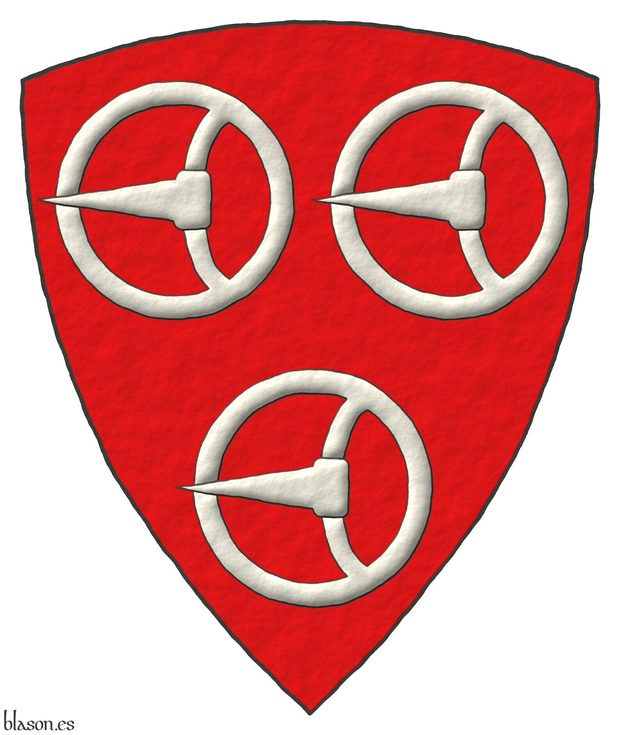
St. George's Roll, in English usually written as «MS Vincent, 164 ff.1-21b», also called [Vincent, MS; 1285], it is in the College of Arms, London, containing 677 painted coats of arms, it is an English roll or arms dating from c. 1285.
The bibliographical reference that I mainly use for this armorial is [Vincent, MS; 1285].
Bibliographical reference of century XIII.
Classification: Armorial roll and Manuscript.
The author is anonymous.
The following articles cite this bibliographic reference:
- Adam de Cretingges
- Bartholomew de Yattendon
- Brian Timms
- Edmund de Bassingburnn
- Howel ap Res
- James de Sottone, le Fitz
- Joan de Okinton
- John de Beauchamp
- John de Ladbrooke
- John le Sturmy
- Nicholas Malmains
- Norman Darcy
- Ricardo de Mandeville
- Robert de Malet
- Simon de Crombe
- Simon de Ver
- Simon le FizSimon
- Thomas Roscelyn
- Thomas de Werblintone
- Thomas le FizThomas
- Vincent, MS; 1285
- Warbrentone, Thomas de
- William Bardolf
- William de Ferrers, Earl of Derby
- William de Hondeshacre


![Ver [Takamiya; 1620] en referencias bibliográficas. Libro abierto, hojas de plata, filo de oro, guardas de gules, tapas de sable.](../css/Libro.Bibliografia.png)
Takamiya; 1620
Anonymous, «Heraldic manuscript of the English kings and peers», Beinecke Rare Book and Manuscript Library, call number Takamiya MS 13, 236 pages, actually 235 due to a pagination error, manuscript on paper in English secretary hand, circa 1620.
Contents
Created circa 1620, this manuscript presents a genealogy of the rulers of England from Brutus and Julius Caesar to James I, including short biographies and more than 600 emblazoned coats of arms in full color. The manuscript spans 236, actually 235 pages, with a pagination error skipping page 182.
Binding
The manuscript is bound in nineteenth-century full polished calf by Clarke & Bedford, with a spine title «Arms of the Nobility of England. MS. 1042-1619». It includes four modern binder's blanks at the front and thirteen at the end.
Provenance
The manuscript originates from England and was part of the Toshiyuki Takamiya collection until 2013. It is classified as a Renaissance manuscript from the 17th century and is a significant resource for the study of English heraldry, genealogy, and nobility.
Bibliographical reference of century XVII.
Classification: Armorial roll, Manuscript, English language and In color.
Author: unknown.
External link:
Internal resources: Takamiya1620.pdf Yale University Library Digital Collections, PDF format.


![Ver [Tejero de Rojas y Sandoval, J. F.; XVII] en referencias bibliográficas. Libro abierto, hojas de plata, filo de oro, guardas de gules, tapas de sable.](../css/Libro.Bibliografia.png)
Tejero de Rojas y Sandoval, J. F.; XVII
Juan Francisco Tejero de Rojas y Sandoval, «Linajes de Aragón, Castilla, León, Galicia, Cataluña, Navarra y Vizcaya», 198 hand-numbered pages, each 2, in Arabic numerals, with numerous blank pages not numbered at the beginning and end, hand index on the back of the last page before the back cover, 22 x 17 centimeters, illustrations in the pages 26-29, in the National Library of Spain, signatures Mss/12617, it is estimated from the XVII century.
Unfinished
Although the last page 198 is signed on the back, the book seems unfinished because at the end of the last page there is a last line with a few loose words «Duke of...» which are a sign that it continues on the next page, but the next page is blank.
Bibliographical reference of century XVII.
Classification: Manuscript, In black and white and Castilian language.
Author: Tejero de Rojas y Sandoval, Juan Francisco.
External resources:
- Detail of this manuscript in the National Library of Spain.
- Bibliographic record of the National Library of Spain.
- Scanned manuscript in the National Library of Spain.
Internal resources: TejeroRojasSandovalJFXVII.Pagina.11.Linajes.pdf.
Credits: This book belongs to the Biblioteca Nacional de España. License Creative Commons CC-BY. You may share, transform and create from images in the public domain that are accessible in the Hispanic Digital Library.


![Ver [Tewkesbury; Century XVII] en referencias bibliográficas. Libro abierto, hojas de plata, filo de oro, guardas de gules, tapas de sable.](../css/Libro.Bibliografia.png)
Tewkesbury; Century XVII
Anonymous, «Founder's and benefactors' book of Tewkesbury abbey», Bodleian Libraries, University of Oxford, call number MS. Top. Glouc. d. 2, recorded in the Catalogue of Western Medieval Manuscripts in Oxford Libraries, manuscript, illustrated, 46 leaves, 245 x 175 millimeters, except fols. 12, 16, and 38, which are smaller, Tewkesbury, beginning of the 16th century.
Origin, historical context, and contents
It is is a medieval manuscript originating from Tewkesbury Abbey at the beginning of the 16th century. This Latin manuscript provides records and depictions of the abbey's founders and benefactors, such as: William Fitzcount, 2nd Earl of Gloucester, died 1183; Oddo and Doddo, Dukes of Mercia; Hugh, great Duke of Mercia, lord of the manor of Tewkesbury, buried at Tewkesbury in 812; Robert Fitzhamon, lord of Creully, Calvados in Normandy, died 1107, and his wife, Sybil, patrons of Tewkesbury Abbey’s reconstruction; Edward Despenser, died 1375; Thomas Despenser, Earl of Gloucester, died 1400; and Isabel Despenser, 1400-1439.
Illustrations and manuscript details
The manuscript is noted for its illustrations, which are believed to have been created by John of Evesham, a monk at Tewkesbury. The illustrations are thought to be copied from painted statues, approximately 70 cm high, which once decorated the abbey church. The manuscript comprises 46 leaves, with most pages measuring 245 x 175 millimeters, though folios 12, 16, and 38 are smaller in size.
In the image, folio 25v depicts Thomas Despenser, Earl of Gloucester, in armor, wearing a red bonnet with a badge, and a mantle with epaulettes over a heraldic surcoat. He holds a sheathed sword and is surrounded by six coats of arms and the badge of the Garter with the flag of Saint George; and folio 26r features a text page with ten coat of arms.
Bibliographical reference of century XVII.
Classification: Manuscript, Armorial roll, Latin language and In color.
The author is unknown.
The following article cites this bibliographic reference:
External link:
Internal resources: 25 images in JPEG format.


![Ver [Urfe; Century XV] en referencias bibliográficas. Libro abierto, hojas de plata, filo de oro, guardas de gules, tapas de sable.](../css/Libro.Bibliografia.png)
Urfe; Century XV
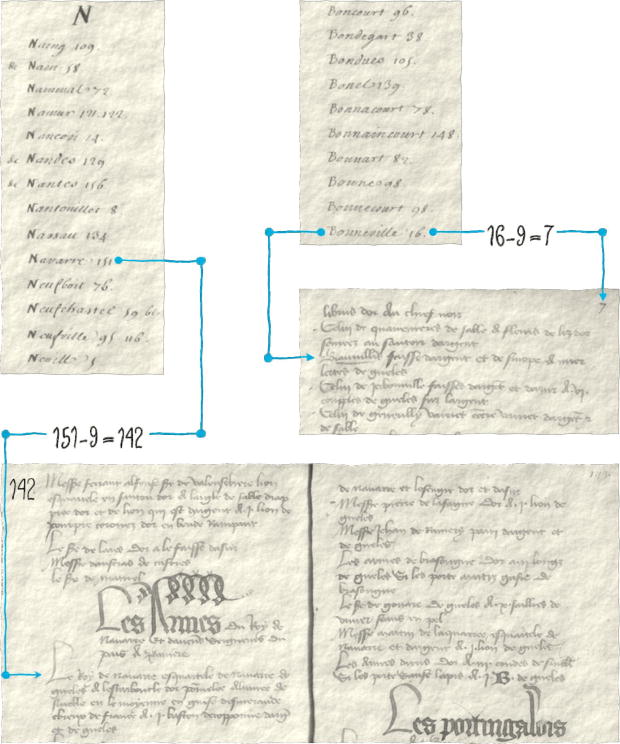
Urfé, unknown authors, «Urfe's Armorial», is currently in National Library of France (BnF, Bibliothèque nationale de France), in Paris, «Cabinet des titres» 927 as indicated on page I, cataloged with the code ms. fr. 32753, it is estimated from the XV century.
This armorial is written in French, on parchment measuring 19.5 x 14 centimeters, its compilation is believed to have been done in the 15th century, it presents 2,855 blazons in written form, but without illustrations, its blazons are organized into 54 sections, with an average of 17 blazons per page, the densest pages with about 20 blazons of 1, 2, or 3 lines per blazon, although some are longer. This Urfé armorial has served as a source for later armorials.
This manuscript contains a preliminary index, written later, of 61 pages, foliated the odd pages in consecutive Roman numerals from folio I to folio XXX. That is, 30 folios of 2 pages plus a final page, totaling 30 x 2 + 1 = 61 pages. This preliminary index consists of a name and a page number where the «theoretically», as will be explained below, corresponding blazon appears.
Next comes the true body of the Urfé armorial, of 162 pages, foliated only the odd pages, dated later than the compilation of the manuscript, in Arabic numerals, 2 by 2, from folio 1 to 161. That is, 1, 3, 5, 7, ..., 159, 161, and the last existing unnumbered page, as it is the 162nd which is even. I say that the 162nd is the last existing page because the National Library of France classifies it as an incomplete manuscript at the end.
It is a bit difficult to understand the relationship between the numbers that appear in the preliminary index, accompanying the names, and the numbering of the pages of the Urfé armorial. For example:
- Bouneville, which in the index appears with the number 16, is blazoned on page 7 (16 - 9 = 7).
- Navarre, for Navarra, in the index appears with the number 151, while the blazon of "Le Roy de Navarre" appears on page 142 (151 - 9 = 142).
This rule of subtracting 9, which has worked for me, but may not be of general use as, for example, Castille~Castile, on page VIII of the index, refers to page 140 of the content and it is there where it is actually found.
The Urfé armorial is in the public domain and the National Library of France, since February 23, 2012, has it published online with identification key ark:/12148/btv1b9063217v.
In this online version, as of today and until corrected, I believe that after page XIX, XVIII and XIX are repeated, just as folio 5 is repeated twice.
Bibliographical reference of century XV.
Classification: Armorial roll, Manuscript, In black and white and French language.
The author is unknown.
The following article cites this bibliographic reference:
External resources:
- Urfe in Gallica BnF.
- Bouneville indexed in the page 16.
- although it is really on the page 7 (16-9=7).
- Navarra indexed in the page 151.
- although it is really on the page 142 (151-9=142).
- Castilla indexed in the page 140.
- is effectively, in this case, on the same page 140.


![Ver [Vincent, MS; 1285] en referencias bibliográficas. Libro abierto, hojas de plata, filo de oro, guardas de gules, tapas de sable.](../css/Libro.Bibliografia.png)
Vincent, MS; 1285
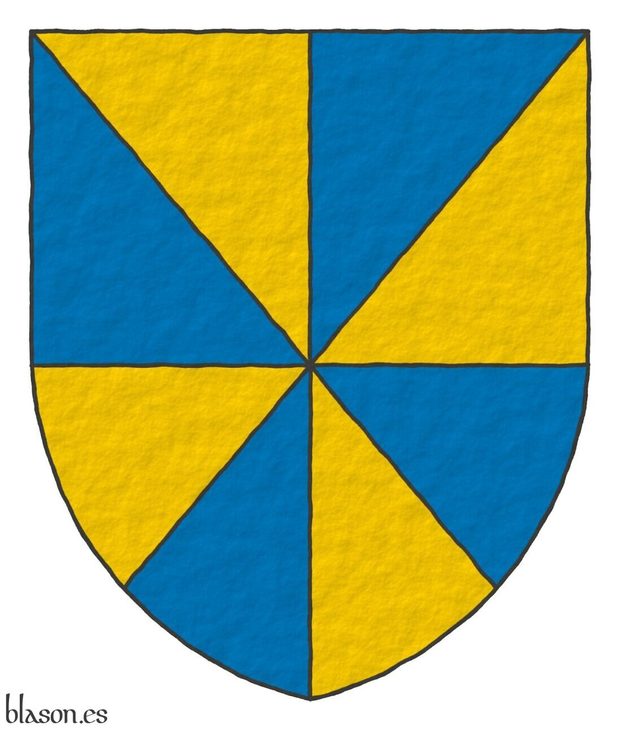
Vincent Manuscript, in English, usually written as «MS Vincent, 164 ff.1-21b», also called [St. George's Roll; 1285], it is in the College of Arms, London, containing 677 painted coats of arms, it is an English roll of arms dating from c. 1285.
Bibliographical reference of century XIII.
Classification: Armorial roll, Manuscript and In color.
The author is anonymous.
Here are the articles quoting this reference:
- Adam de Cretingges
- Bartholomew de Yattendon
- Edmund de Bassingburnn
- Howel ap Res
- James de Sottone, le Fitz
- Joan de Okinton
- John de Beauchamp
- John de Ladbrooke
- John le Sturmy
- Nicholas Malmains
- Norman Darcy
- Ricardo de Mandeville
- Robert de Malet
- Simon de Crombe
- Simon de Ver
- Simon le FizSimon
- St. George's Roll; 1285
- Thomas Roscelyn
- Thomas de Werblintone
- Thomas le FizThomas
- William Bardolf
- William de Ferrers, Earl of Derby
- William de Hondeshacre
-
Language
-
Categories of heraldry
-
Divisions of the field
- Without divisions
- Party per pale
- Party per fess
- Party per bend
- Party per bend sinister
- Tierce
- Tierce sinister
- Tierced per pale
- Tierced per fess
- Tierced per bend
- Tierced pallwise inverted
- Quarterly
- Quarterly per saltire
- Gyronny
- Party per fess, the chief per pale
- Party per pale, the sinister per fess
- Party per fess, the base per pale
- Party per pale, the dexter per fess
- Chapé
- Chaussé
- Embrassé
- Contre-embrassé
- Party per chevron
- Enté
- Enté en point
- Flanched
-
Metals
-
Colours
-
Furs
-
Other tinctures
-
Ordinaries and sub-ordinaries
-
Diminutives of the ordinaries
-
Geometric charges
-
Composite ordinaries
-
Inanimate charges from Nature
Atom, Crescent, Diamond, Emerald, Estoile, Increscent, Lightning flash, Moon, Mount, Mullet, Mullet of four points, Orbital, Plough of Ursa Major, Rainbow, Ray of the sun, River, Sea, Snowflake, Sun, Sun in splendour, Sun of May, Trimount, Water and Wave.
-
Vegetal charges from Nature
Acorn, Apple, Apple tree, Ash, Bluebonnet, Camellia, Chrysanthemum, Cinquefoil, Cornflower, Dogwood flower, Double rose, Elm, Fleur de lis, Flower, Gourd, Holm oak, Hop cone, Kapok tree, Laurel, Lily, Linden, Lotus flower, Madonna lily, Mexican cedar tree, Oak, Olive tree, Palm tree, Plantain plant, Pomegranate, Poplar leaf, Rose, Shamrock, Sunflower, Thistle, Tree, Tulip, Vine and Wheat.
-
Animal charges from Nature
Badger, Bald eagle, Barbel, Barn owl, Bear, Beaver, Beetle, Bighorn sheep, Blackbird, Boar, Brach hound, Bull, Doe, Dog, Dolphin, Dove, Eagle, Elephant, Falcon, Female figure, Fish, Flame, Fly, Fox, Frog, Goat, Goldfinch, Goose, Heron, Horse, Hummingbird, Jaguar, Lark, Leopard, Lion, Lion passant, Lion rampant guardant, Lioness, Lynx, Male figure, Martlet, Merino ram, Owl, Panther, Parrot, Peacock, Pelican, Pelican in her piety, Puffin, Quetzal, Raven, Roe deer, Rooster, Savage, Seagull, Serpent, She-wolf, Stag, Starling, Talbot, Tyger, Vulture, Warren hound and Wolf.
-
Parts of natural charges
Arm, Beak, Branch, Caboshed, Chest, Claw, Covert, Dorsal fin, Eagle claw, Ermine spot, Escallop, Feather, Foot (palmiped), Foreleg, Forepaw, Hand, Head, Heart, Hoof, Leaf, Neck, Ostrich feather, Palm frond, Paw, Roe deers' attires, Shoulder, Sprig, Stags' attires, Stem, Swallow-tail, Tail, Tail addorsed, Tail fin, Talon, Tooth, Trunk, Trunk (elephant), Two hands clasped, Two wings in vol, Udder, Wheat spike, Wing and Wrist.
-
Artificial charges
Ace of spades, Anchor, Anvil, Arch, Arm vambraced, Armillary sphere, Arrow, Axe, Bell, Bell tower, Beret, Bonfire, Book, Bookmark, Bow, Branding iron, Bridge, Broken, Buckle, Cannon, Cannon dismounted, Cannon port, Canopy roof, Carbuncle, Castle, Celtic Trinity knot, Chain, Chess rooks, Church, Clarion, Clay pot, Closed book, Club, Column, Comb, Compass rose, Conductor's baton, Cord, Covered cup, Crozier, Crucible, Cuffed, Cup, Cyclamor, Dagger, Double vajra, Drum, Ecclesiastical cap, Fanon, Federschwert, Fleam, Four crescents joined millsailwise, Galician granary, Garb, Gauntlet, Geometric solid, Grenade, Halberd, Hammer, Harp, Host, Hourglass, Key, Key ward, Knight, Knot, Lantern, Letter, Line, Loincloth, Menorah, Millrind, Millstone, Millwheel, Monstrance, Mortar, Mullet of six points pierced, Nail, Non-classic artifact, Norman ship, Number, Oar, Oil lamp, Open book, Page, Pair of scales, Parchment, Pestle, Piano, Pilgrim's staff, Plough share, Polish winged hussar, Port, Portcullis, Potent, Quill, Ribbon, Rosette of acanthus leaves, Sabre, Sackbut, Sail, Scroll, Scythe, Sheaf of tobacco, Ship, Skirt, Spear, Spear's head, Stairway, Star of David, Step, Sword, Symbol, Tetrahedron, Torch, Tower, Trident, Trumpet, Turret, Two-handed sword, Wagon-wheel, Water-bouget, Wheel, Winnowing fan and With a turret.
-
Immaterial charges
Angel, Archangel, Basilisk, Dragon, Dragon's head, Garuda, Golden fleece, Griffin, Heart enflamed, Justice, Mermaid, Our Lady of Mercy, Ouroboros, Paschal lamb, Pegasus, Phoenix, Sacred Heart of Jesus, Saint George, Sea-griffin, Trinity, Triton, Unicorn, Winged hand and Wyvern.
-
External elements
-
Heraldic creations
-
References
-
Formats
-
Keywords on this page
Armorial roll, Azure, Bend, Bibliography, Surmounted, Chain, Five, In black and white, In color, Mullet, Genealogy, German language, Castilian language, Classical Chinese language, French language, English language, Latin language, Portuguese language, Lineage, Manuscript, Orle, Or, Argent, Without divisions, Kingdom of Castile and Leon, Kingdom of England, Sable, Century XI, Century XIII, Century XIV, Century XV, Century XVI, Century XVII, Century XVIII, Century XX and Video.

